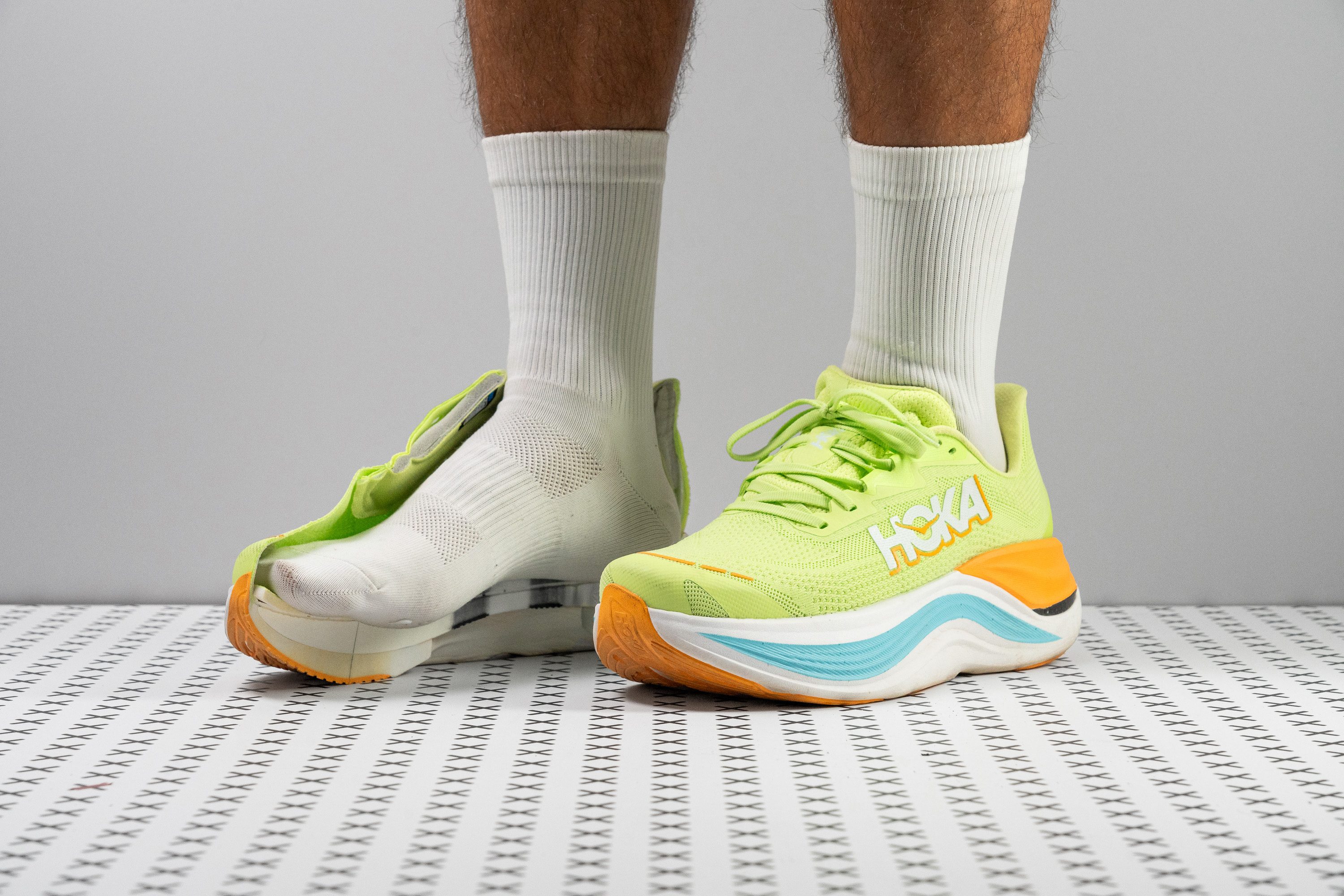Our verdict
Pros
- Exceptional cushioning
- Innovative H-shaped carbon plate
- Tank-like durability
- Comfy knit upper
- Excellent stability
- Superior PEBA foam
- Smooth rockered ride
- Fantastic energy return
Cons
- Excessively heavy
- Narrow fit
- Not for fast paces at all
Audience verdict
- Top 19% most popular running shoes
Comparison
The most similar running shoes compared
+ + Add a shoe | |||||
|---|---|---|---|---|---|
| Audience score | 86 Good! | 85 Good! | 88 Great! | 84 Good! | |
| Price | £185 | £230 | £250 | £200 | |
| Pace | Daily runningTempo | Tempo | CompetitionTempo | Daily running | |
| Shock absorption | High | High | High | - | |
| Energy return | High | High | High | - | |
| Traction | High | High | High | - | |
| Arch support | Neutral | Neutral | Neutral | Neutral | |
| Weight lab Weight brand | 11.1 oz / 315g 10.8 oz / 306g | 9.8 oz / 278g 9.8 oz / 278g | 10.8 oz / 305g 10.8 oz / 306g | 9.7 oz / 274g 8.8 oz / 250g | |
| Drop lab Drop brand | 9.2 mm 5.0 mm | 7.3 mm 6.0 mm | 8.8 mm 6.5 mm | 9.4 mm 5.0 mm | |
| Strike pattern | HeelMid/forefoot | Mid/forefoot | HeelMid/forefoot | HeelMid/forefoot | |
| Size | True to size | True to size | Slightly small | True to size | |
| Midsole softness | Soft | Soft | Balanced | Balanced | |
| Difference in midsole softness in cold | Small | Normal | Small | Small | |
| Toebox durability | Good | Bad | Good | Bad | |
| Heel padding durability | Good | Good | Good | Bad | |
| Outsole durability | Good | Decent | Good | Good | |
| Breathability | Breathable | Moderate | Moderate | Breathable | |
| Width / fit | Narrow | Medium | Medium | Medium | |
| Toebox width | Narrow | Medium | Narrow | Medium | |
| Stiffness | Stiff | Stiff | Stiff | Stiff | |
| Torsional rigidity | Stiff | Stiff | Stiff | Stiff | |
| Heel counter stiffness | Stiff | Moderate | Flexible | Stiff | |
| Plate | Carbon plate | Carbon plate | Carbon plate | Carbon plate | |
| Rocker | ✓ | ✓ | ✓ | ✓ | |
| Heel lab Heel brand | 46.3 mm 49.0 mm | 36.8 mm 41.0 mm | 45.7 mm 50.0 mm | 40.2 mm 35.0 mm | |
| Forefoot lab Forefoot brand | 37.1 mm 44.0 mm | 29.5 mm 35.0 mm | 36.9 mm 43.5 mm | 30.8 mm 30.0 mm | |
| Widths available | Normal | NormalWide | Normal | Normal | |
| Orthotic friendly | ✓ | ✓ | ✓ | ✓ | |
| Season | SummerAll seasons | All seasons | All seasons | SummerAll seasons | |
| Removable insole | ✓ | ✓ | ✓ | ✓ | |
| Ranking | #171 Top 46% | #207 Bottom 44% | #131 Top 36% | #232 Bottom 37% | |
| Popularity | #71 Top 19% | #41 Top 11% | #68 Top 19% | #233 Bottom 37% |
Who should buy
We've rigorously tested the Skyward X in our lab and confidently recommend it for:
- Bondi 8 and Bondi X enthusiasts seeking even greater cushioning and energy return—this supertrainer features PEBA and steps up the game!
- Runners in search of a carbon-plated, max-cushioned shoe that combines durability with top-tier performance.
- Marathoners looking for a premium long-run shoe that also works well at recovery runs if needed.
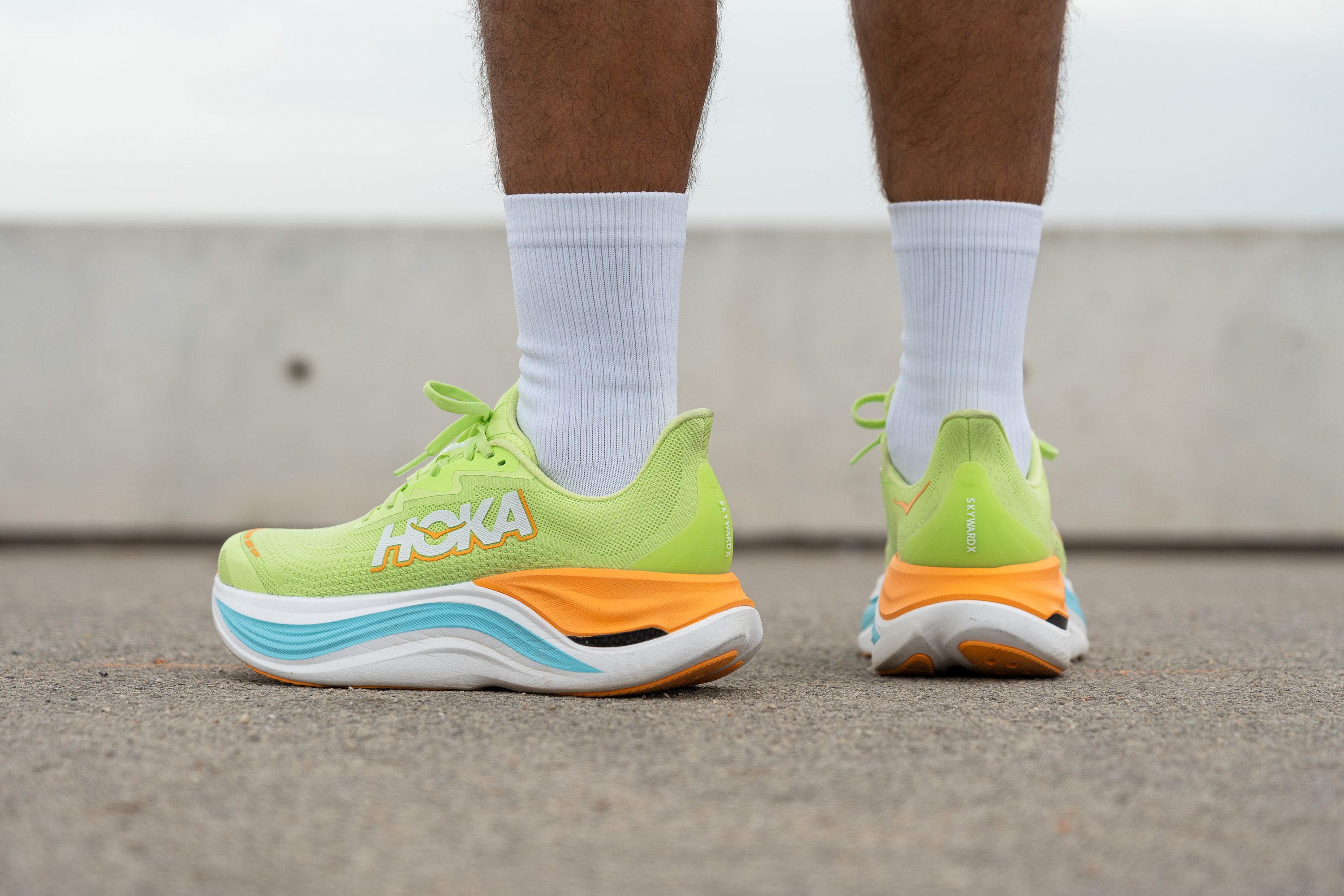
Who should NOT buy
The Skyward X might be a real supertrainer, but it's a heavy one. We think if you're looking for a lighter max-stack shoe, you should check out the ASICS Superblast 2 or the ASICS Magic Speed 4. Both of these are much lighter and work better for fast running.
We've also observed that this shoe is too narrow for many runners, including those with normal-sized feet who prefer a roomier fit. If you're looking for more space, the On Cloudmonster Hyper provides ample room in the toebox. And inside the Hoka lineup, the Mach X is super responsive and offers a slightly wider fit than the Skyward X, as we proved in the lab.
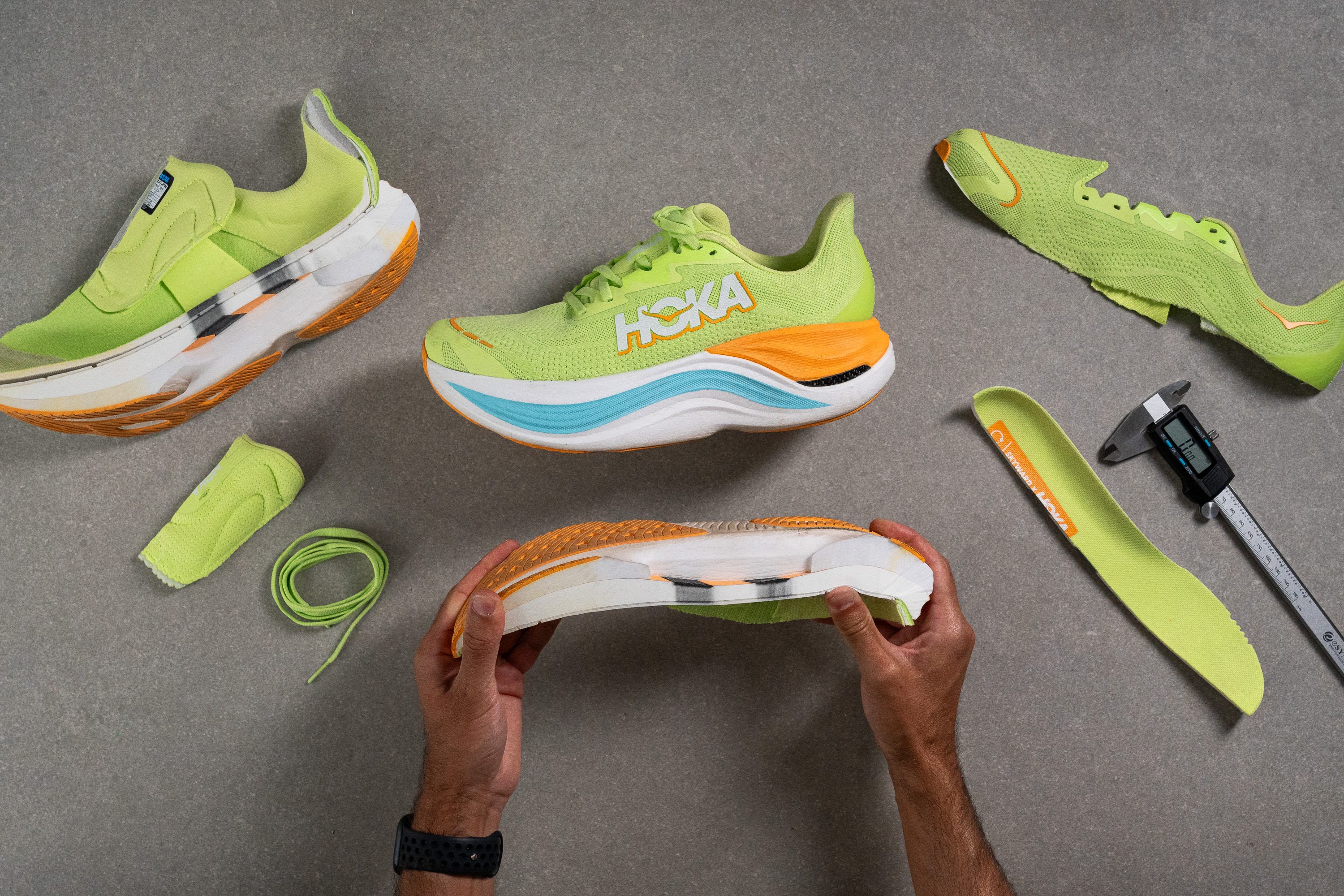
Cushioning
Shock absorption
The Skyward X looks massive, and the shock absorption numbers we recorded match the design. With 136 SA in the heel and a crazy-high 139 SA in the forefoot, it’s built for runners seeking maxed-out protection underfoot.
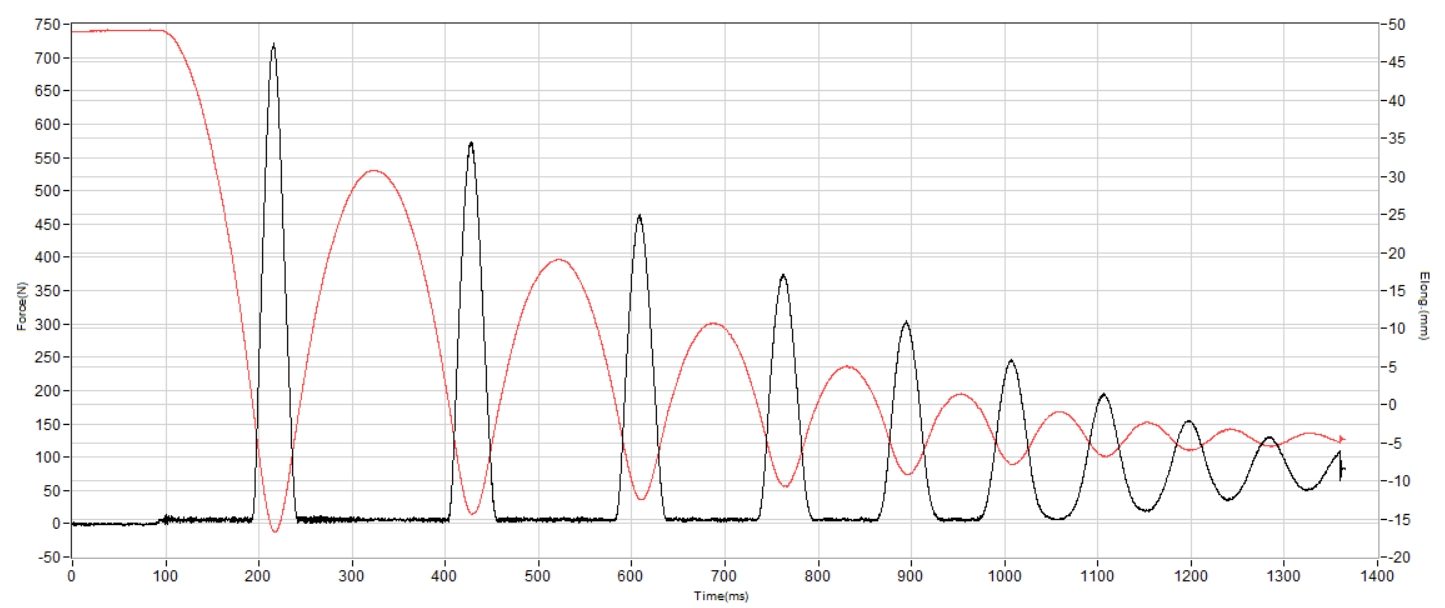
| Hoka Skyward X | 136 SA |
| Average | 129 SA |
Energy return
Hoka boosted energy return in this model by adding a PEBA layer above the supercritical EVA. This upgrade pushed the numbers well past 60%, landing at 66.2% in the heel and 68.5% in the forefoot. Those are solid figures for a supertrainer.
| Hoka Skyward X | 66.2% |
| Average | 58.5% |
Heel stack
The Skyward X easily ranks in the top three most impressive unboxings due to its massive size. Now, let's delve into some specific measurements.
Starting with the heel stack, the Skyward X categorically places itself among supertrainers with a towering 46.3 mm stack height—a dream come true for heavyweight heel strikers seeking world-class impact absorption.
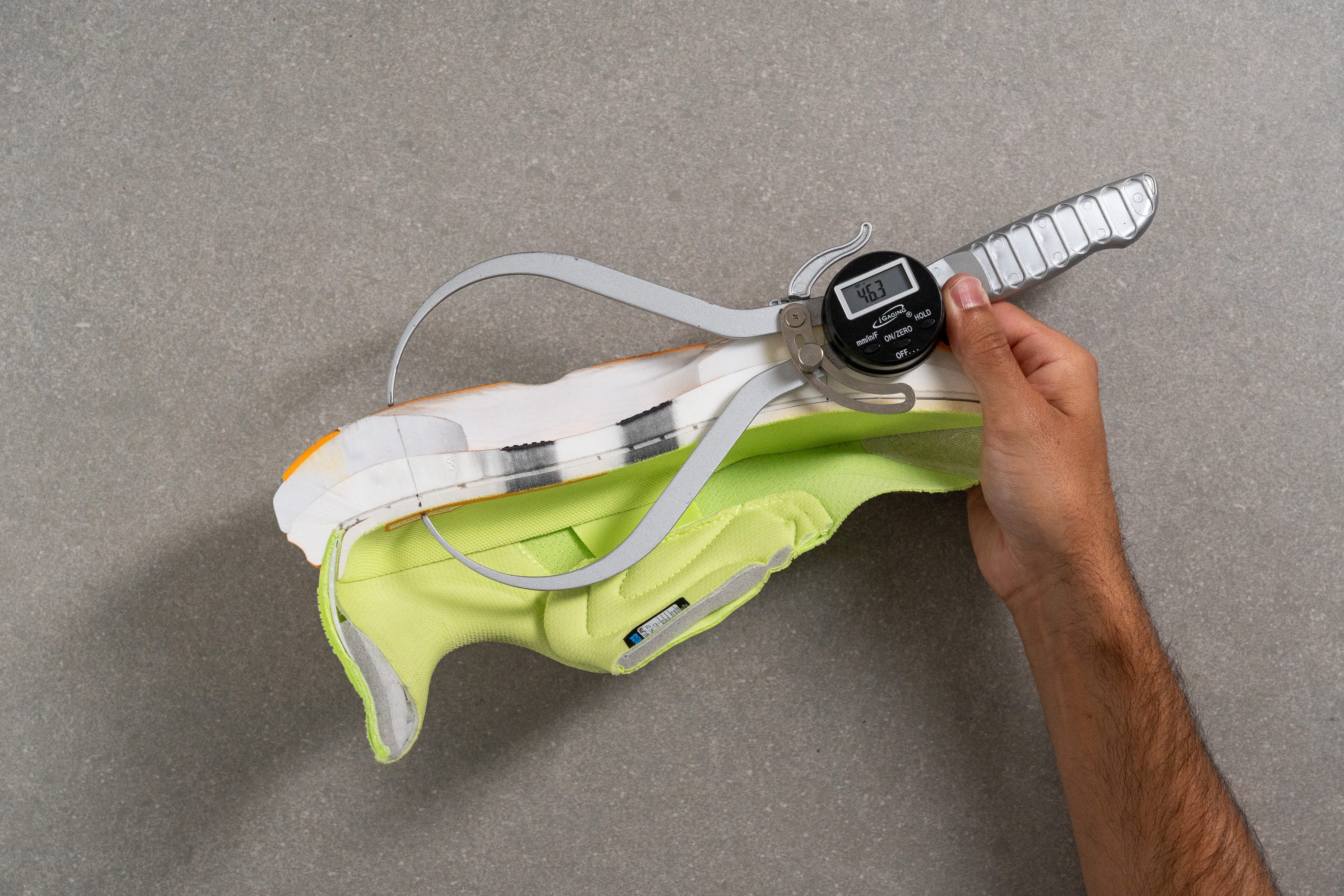
| Hoka Skyward X | 46.3 mm |
| Average | 34.8 mm |
Forefoot stack
The Skyward X not only features an impressive 37.1 mm of cushioning in the forefoot—surpassing nearly every heel cushioning we've measured in the lab—but it also makes an excellent choice for marathoners.
These enthusiasts of the Sunday long run, often covering distances exceeding even 20 miles, will find that the extensive cushioning of the Skyward X preserves their muscles, offering a notable advantage over less cushioned options for high-mileage training.
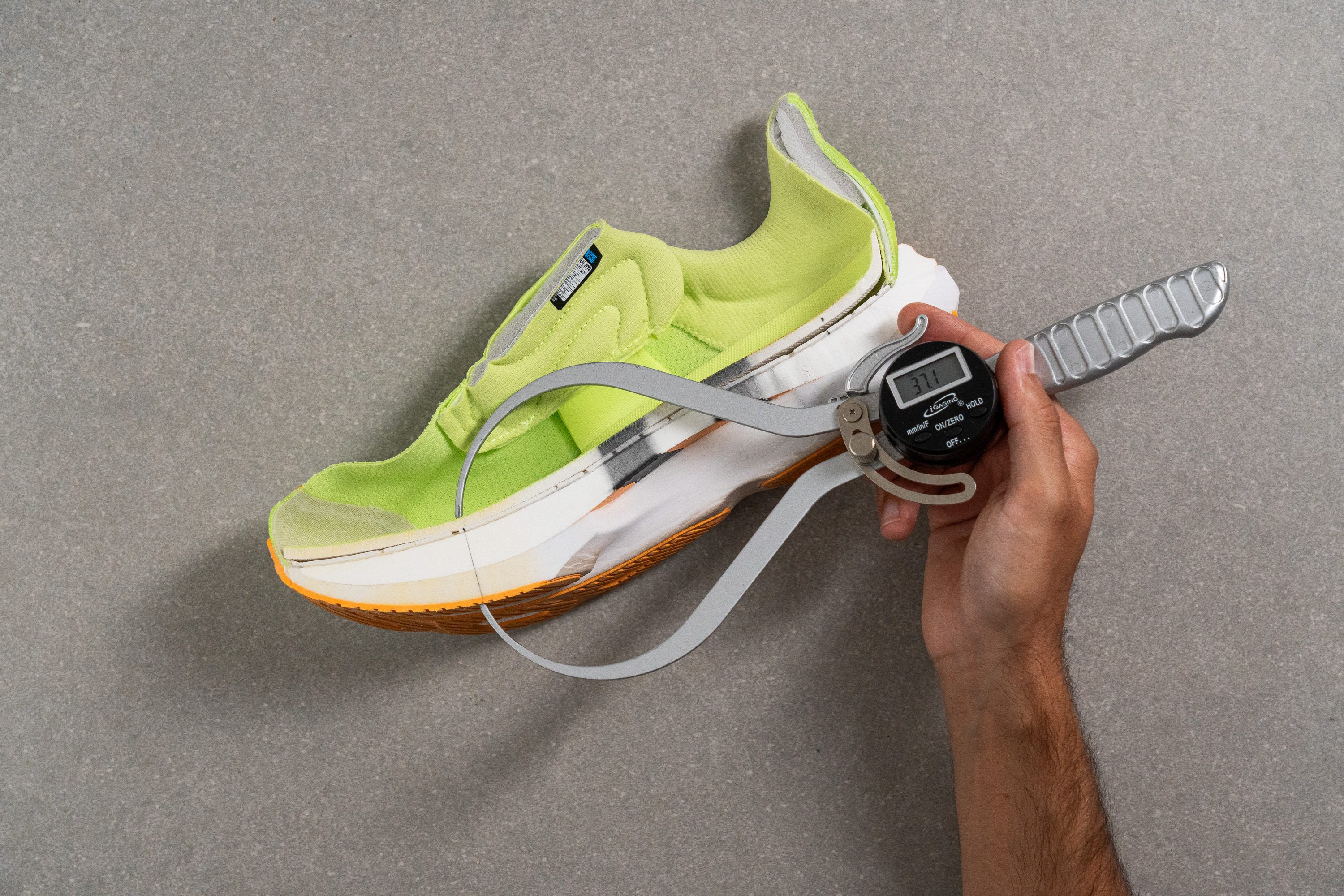
| Hoka Skyward X | 37.1 mm |
| Average | 26.2 mm |
Drop
After evaluating the heel and forefoot stacks, our measurements revealed a 9.2 mm drop—good for most running styles and particularly beneficial for heel strikers seeking long-distance comfort.
Interestingly, Hoka claims a 5 mm drop, a huge discrepancy with our findings. For anyone wondering about these discrepancies, we're ready to provide clear explanations!

| Hoka Skyward X | 9.2 mm |
| Average | 8.6 mm |
Midsole softness
The Skyward X from Hoka captures attention with its colossal midsole—let's dive into the details.
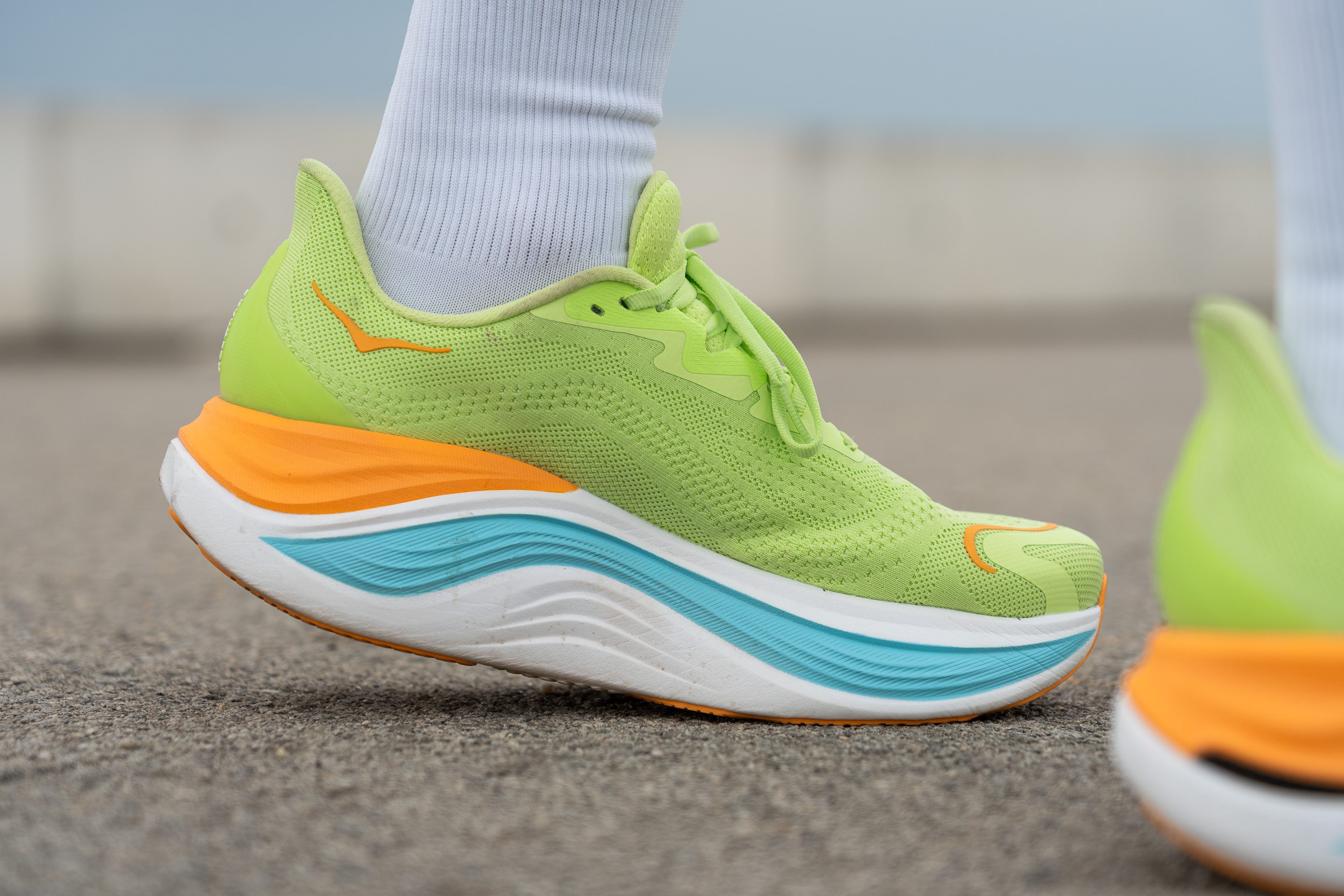
This model features a dual-foam configuration, which is the norm in supertrainers. The top layer is crafted from premium PEBA—as expected in any shoe priced over £200—offering excellent energy return, similar to top-tier models like the Hoka Rocket X 2.
We tested the softness of the PEBA layer with our durometer and recorded a measurement of 19.8 HA. It doesn't feel like walking on clouds by any means, avoiding the overly plush feel that can undermine stability in such a tall shoe.
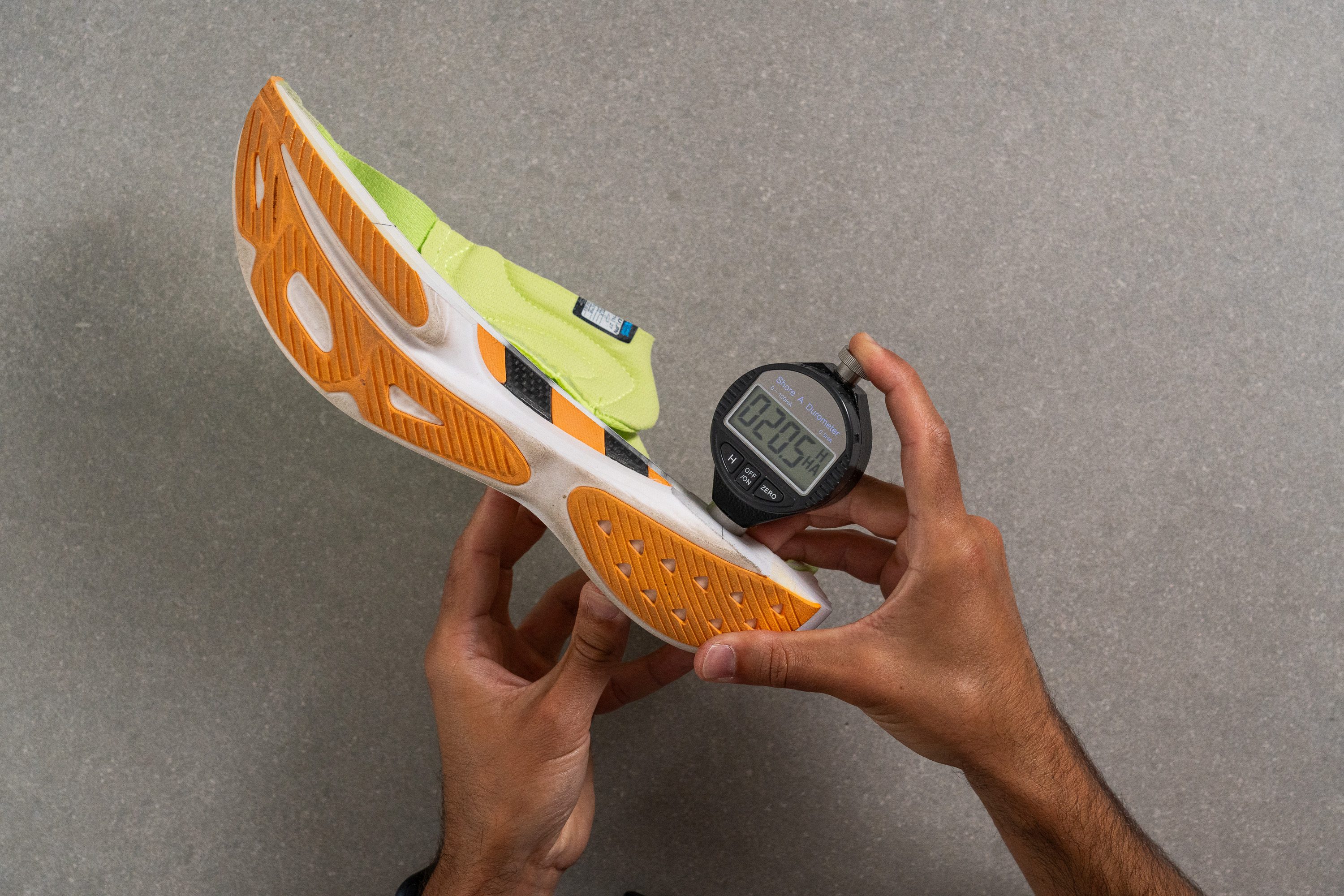
| Hoka Skyward X | 19.8 HA |
| Average | 20.4 HA |
Secondary foam softness
The lower layer of the Skyward X's midsole is crafted from supercritical EVA, not PEBA, aligning with the foam used in Hoka's recent training shoes. This layer is softer than the other, enhancing comfort with each step due to its significant compression. Yet of course, with over 40 mm of stack height, expect no ground feel in the Skyward X.
Why not use a full-PEBA midsole like in the Cielo X1? We think there are several reasons. Incorporating a softer EVA base enhances durability by shielding the more delicate PEBA from direct ground impact, and significantly cuts manufacturing costs since EVA is much less expensive than PEBA.
Nonetheless, at £220, the use of EVA is in the limit. To put it in perspective, the Saucony Endorphin Pro 4 offers a full-length carbon plate and a 100% PEBA-based midsole for the same price.
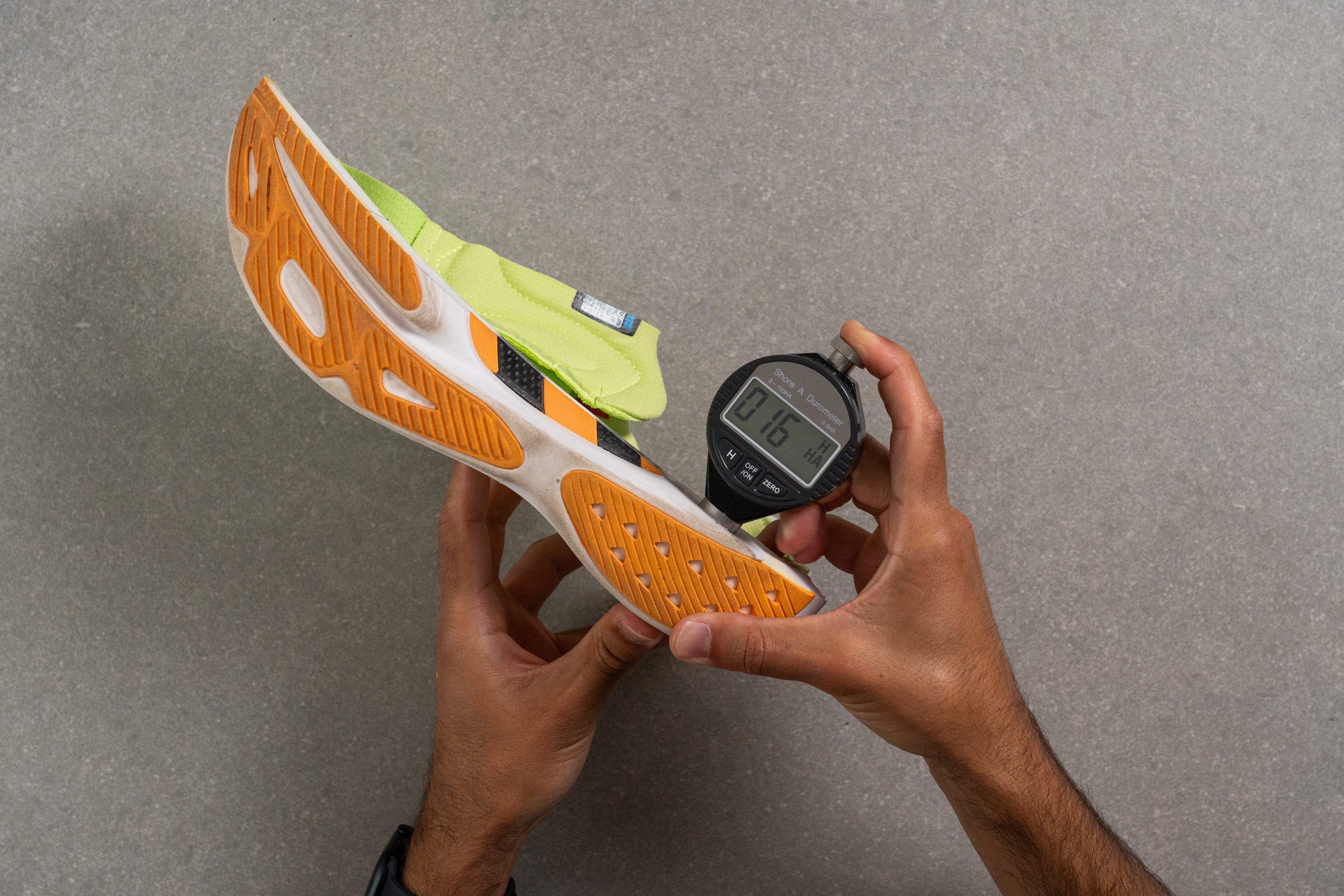
| Hoka Skyward X | 16.0 HA |
| Average | 22.7 HA |
Rocker
The Skyward X stands out as one of the most rockered shoes we've tested in our lab, featuring a pronounced continuous curve that's clearly visible in our video below. This curvature is crucial, particularly given the shoe's colossal stack height and stiffness, ensuring smooth transitions.
For those interested in exploring more about rockered running shoes, we offer a detailed guide that covers everything you need to know.
Plate
Hoka introduces a significant innovation in the Skyward X—not just inserting any ordinary carbon plate but crafting an all-new, H-shaped design. This innovation aims to provide the dual benefits of carbon plate snappiness and added flexibility for more relaxed paces.
Yet, we question whether a carbon plate is necessary in a training shoe, especially considering the cost increase it brings to the consumer. While nylon-plated shoes like the Endorphin Speed 4 manage easy paces without excessive stiffness, the Skyward X caters only to those who prefer the stiff feel of carbon in a training context.
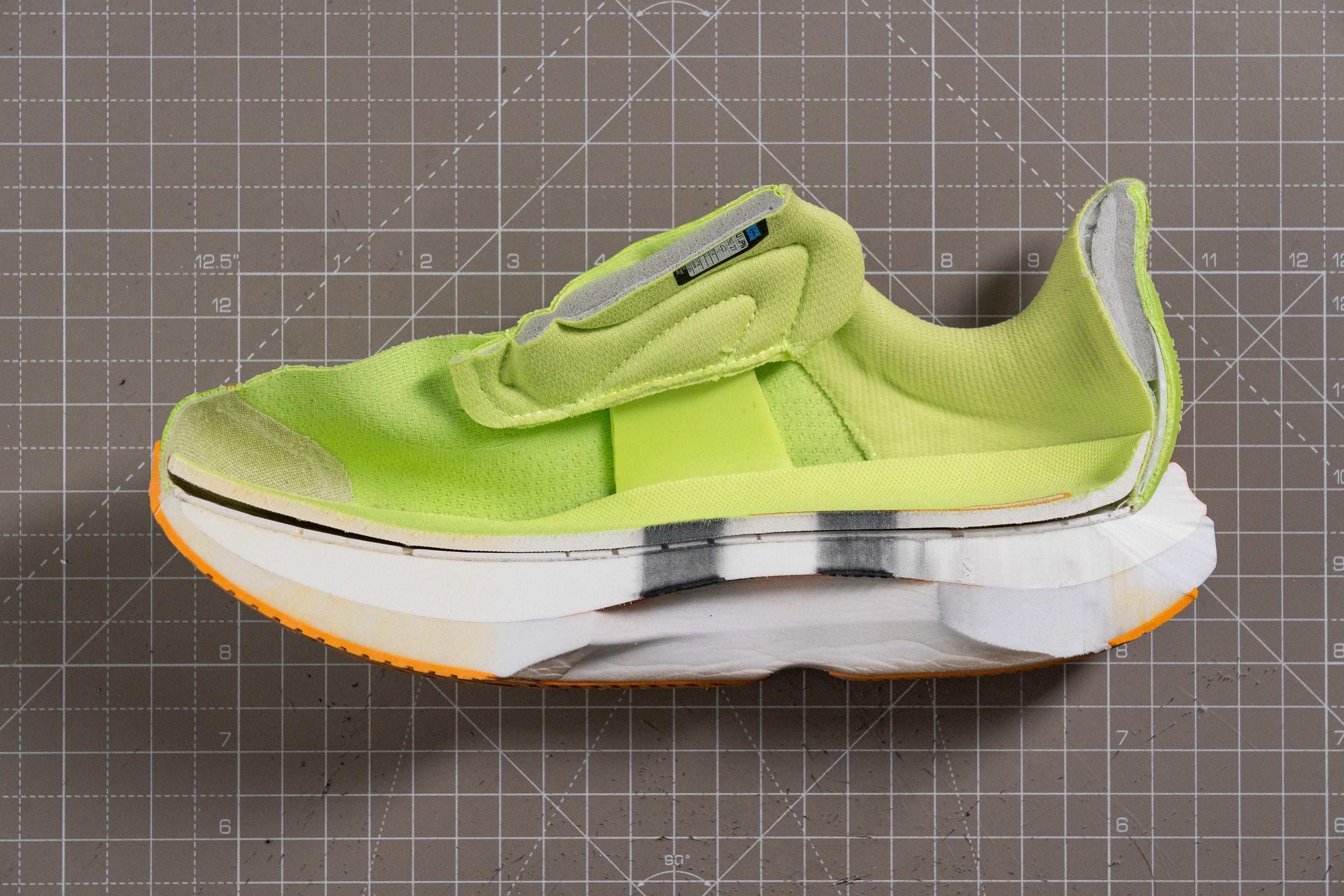
Size and fit
We conducted our second measurement in the toebox around the big toe area, where it measures a reasonable 77.0 mm—slightly wider than expected.
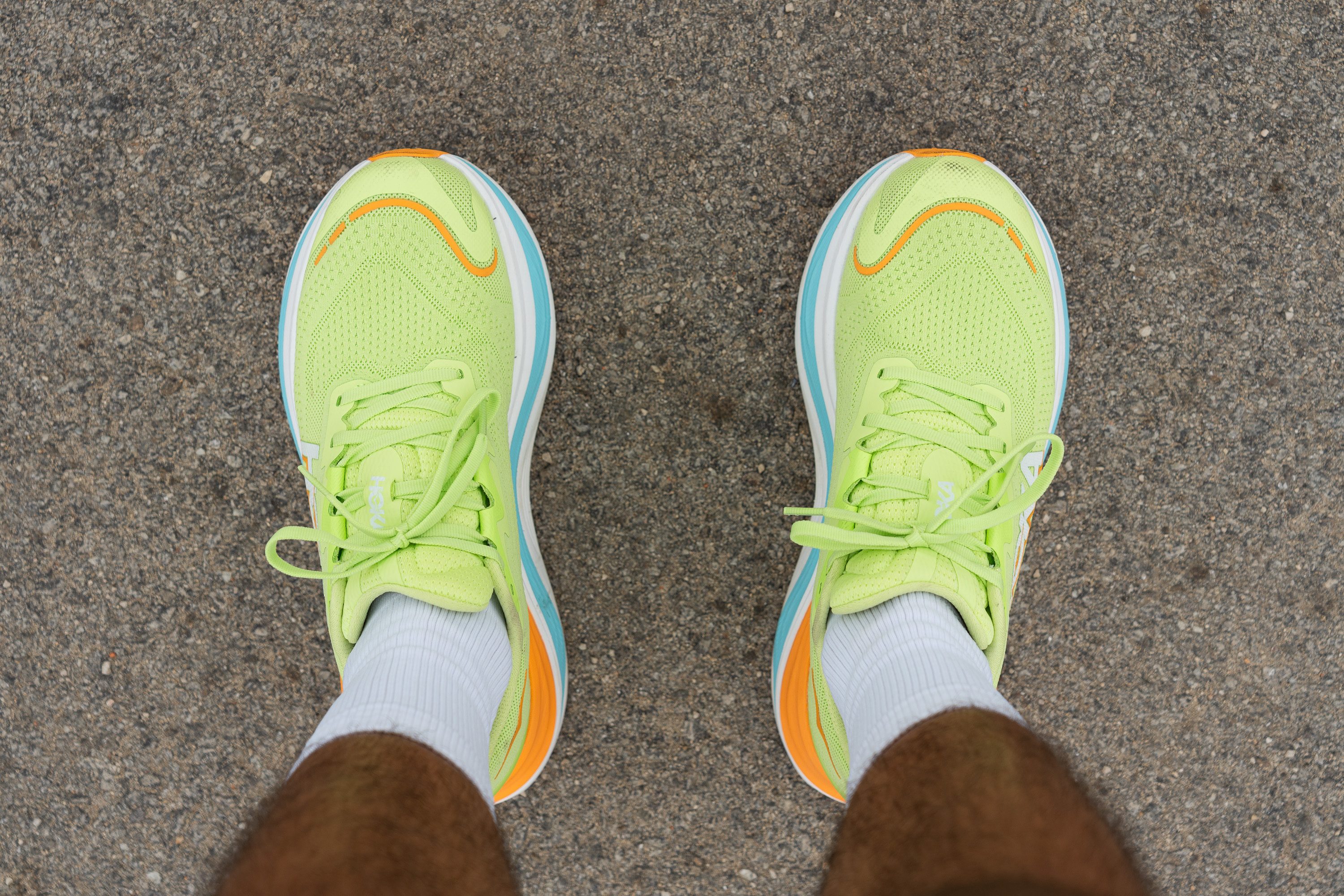
This width makes the shoe suitable for those with average-sized feet. However, it's crucial to note again that this model doesn't offer much volume. Instead, it opts for a snugger fit, which may not suit everyone.
Size
Hoka Skyward X fits true to size (74 votes).
Width / Fit
We always start by testing every shoe on our feet before measuring. Right away, the Skyward X felt snug, a feeling we later quantified with a measurement of 92.1 mm across the widest part of the 1:1 gel mould we created.
For those familiar with this brand, the classic Hoka-esque performance fit won't come as a surprise—most times it features a narrow toebox.

| Hoka Skyward X | 92.1 mm |
| Average | 95.1 mm |
Toebox width
Our second measurement focused on the toebox, revealing that the narrowness extends consistently to the shoe's tip (69.1 mm).

In our opinion, this design caters exclusively to narrow feet or those with average-sized feet seeking a snug, secure fit.
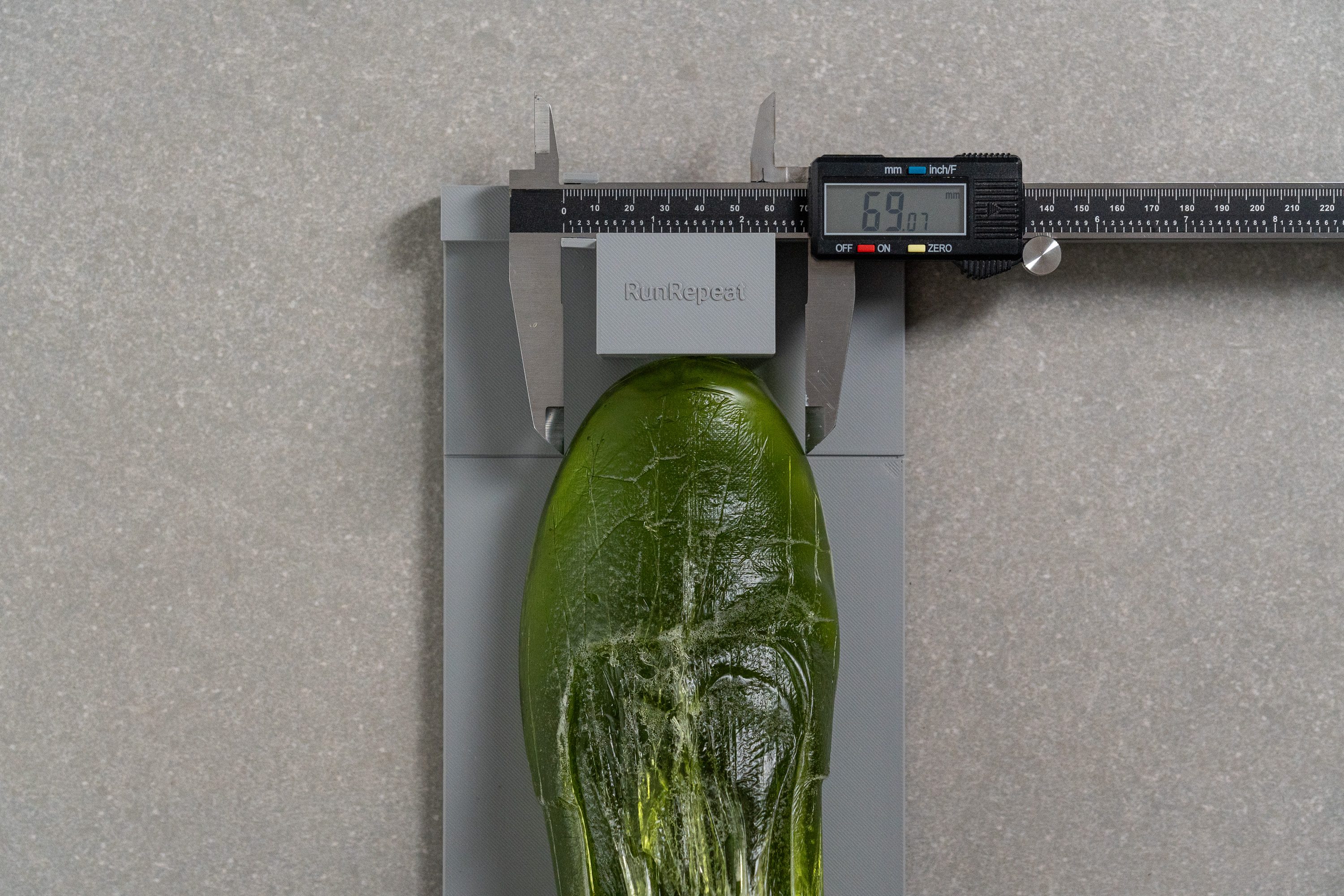
| Hoka Skyward X | 69.1 mm |
| Average | 73.2 mm |
Toebox height
In contrast to our previous two measurements, the third—focused on toebox height—exceeded the average, offering plenty of space for upward toe movement with a measurement of 28.4 mm.
This means those familiar with Hoka's fit will get exactly that, but with the bonus of extra vertical space.

| Hoka Skyward X | 28.4 mm |
| Average | 27.1 mm |
Traction / Grip
Traction test
The massive footprint of the Skyward X boosts surface contact, giving it a natural edge in grip over most standard Hoka shoes. This showed in our wet-grip test, where it achieved a solid 0.50. Compared to many Hoka daily trainers, the Skyward X stands out, guaranteeing excellent traction on dry roads as well.
| Hoka Skyward X | 0.47 |
| Average | 0.48 |
Outsole design
The outsole offers good coverage and features a huge central groove. This design not only reduces weight but also highlights the H-shaped carbon plate.
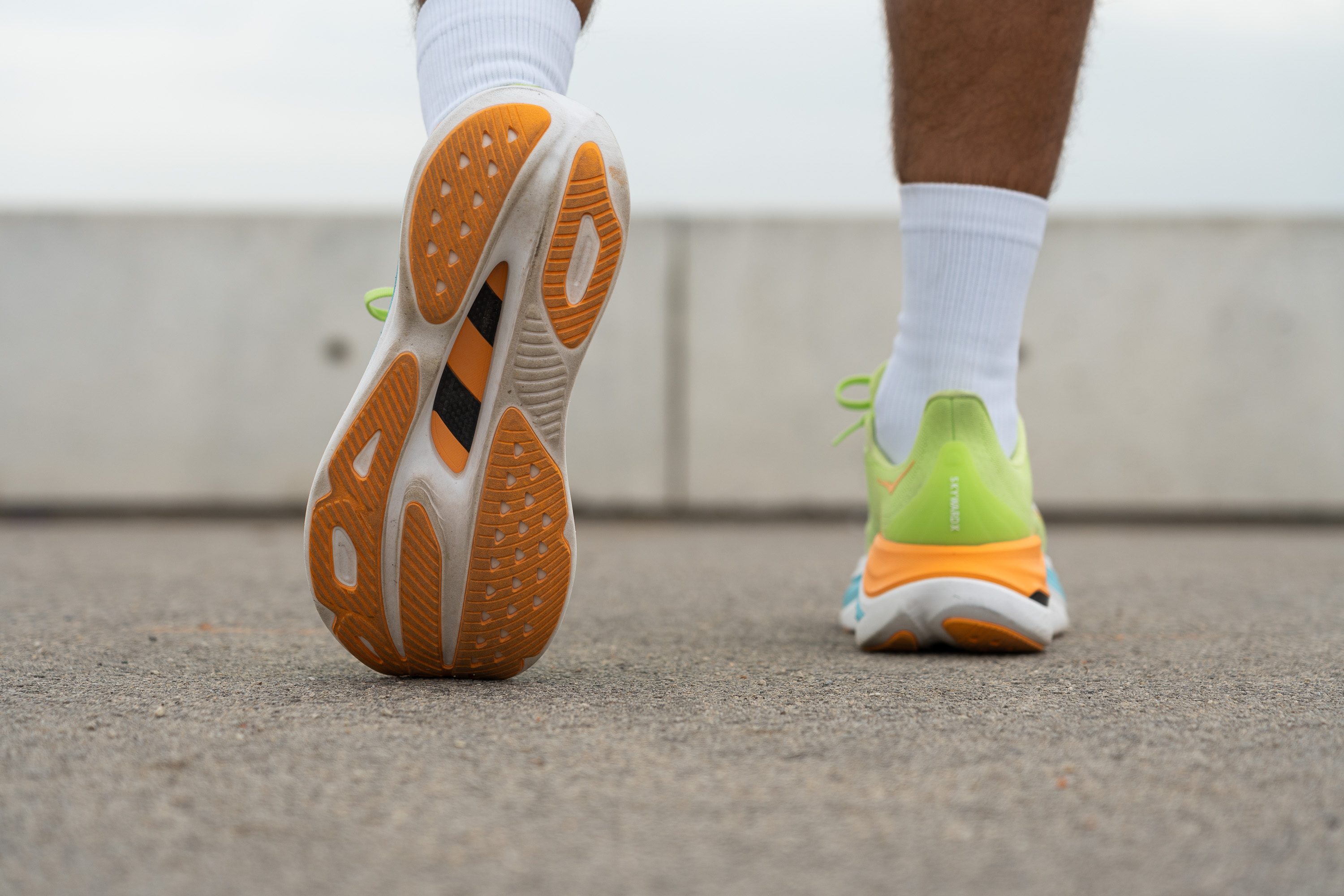
Flexibility / Stiffness
A carbon-fibre plate paired with a thick midsole typically leads to significant stiffness—basic running 101. Naturally, we rigorously tested this claim.
In our bend test—where we flex the shoe up to 30 degrees from a fixed position with our custom machine—we needed to apply 28.5N of force, aligning perfectly with our expectations. Consequently, brace for a notably stiff ride and set aside any thoughts of using this shoe for casual walking or gym workouts.

| Hoka Skyward X | 28.5N |
| Average | 15.3N |
Stiffness in cold (%)
After a second 20-minute session in the freezer, we repeated the test and observed a comparable result: 55.5N. With a minimal increase of just 2.5%, the Skyward X meets our expectations for a PEBA-based midsole, which typically exhibits good behaviour against temperature fluctuations.
| Hoka Skyward X | 3% |
| Average | 33% |
Weight
It's unmistakably true that the Skyward X is both wide and tall, yet it's equally clear that Hoka hasn't prioritised reducing its weight.
At 11.1 oz or 315g, its heft was noticeable on every run, whether we were going slow or fast.
So, the real question is—does weight matter to you? If so, the Skyward X might not meet your expectations, especially if you want a supertrainer for faster paces. However, if you're open to sacrificing some lightness for exceptional cushioning and comfort, this could very well be the maximalist giant you've been waiting for.
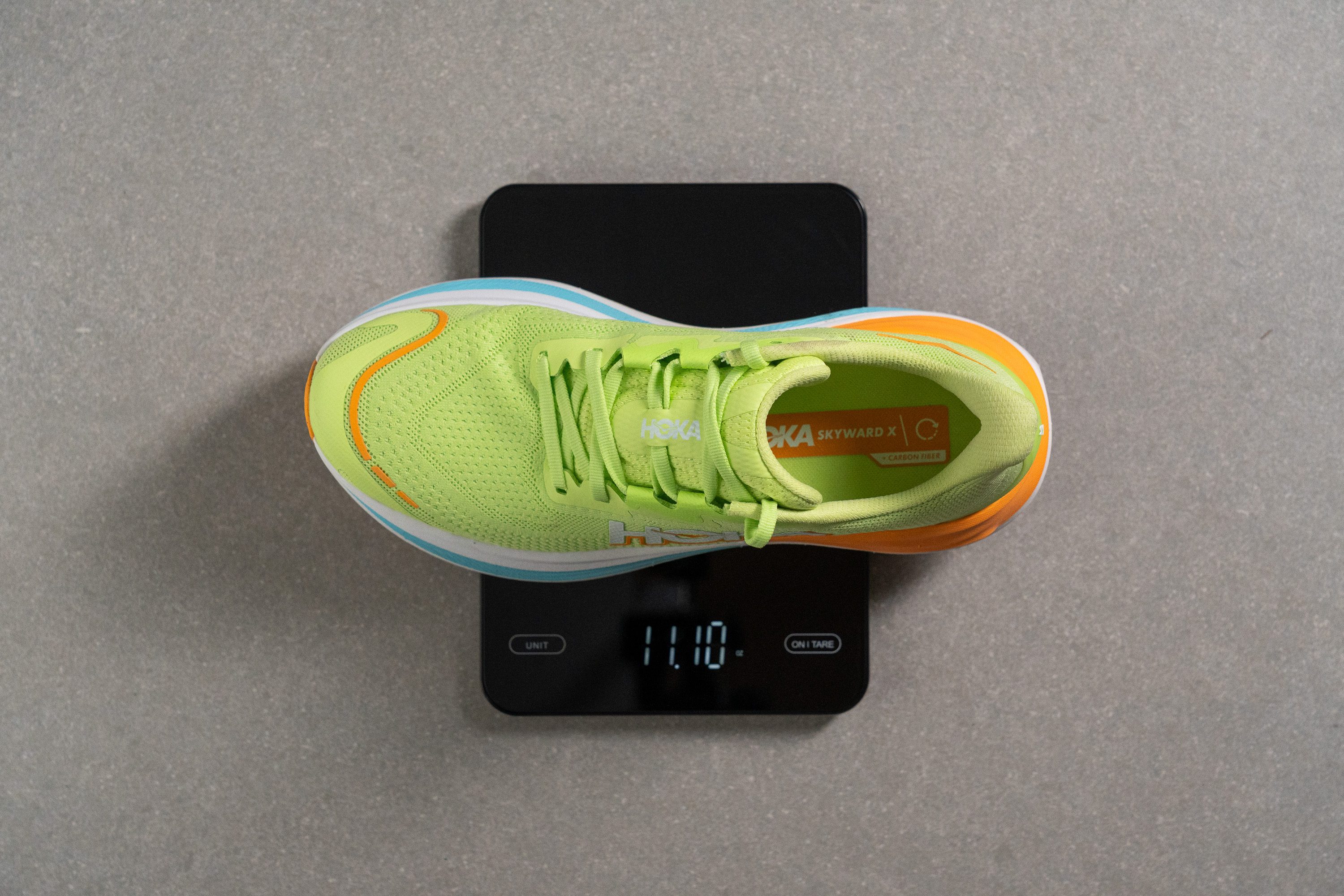
| Hoka Skyward X | 11.1 oz (315g) |
| Average | 9.3 oz (264g) |
Breathability
Initially, we were quite sceptical about the flat knit upper of the Skyward X—typically, they underperform in our breathability tests, particularly when compared to engineered mesh uppers. But, surprisingly, this one excelled and got a 5/5.
During our smoke test, we discovered that the Skyward X boasts exceptional ventilation, making it well-suited for runs even during the hottest months of the year.
We used a light to closely examine how Hoka structured the upper for both ventilation and support. We observed that the toebox is remarkably thin, extending to the midfoot before it thickens, enhancing lateral stability.
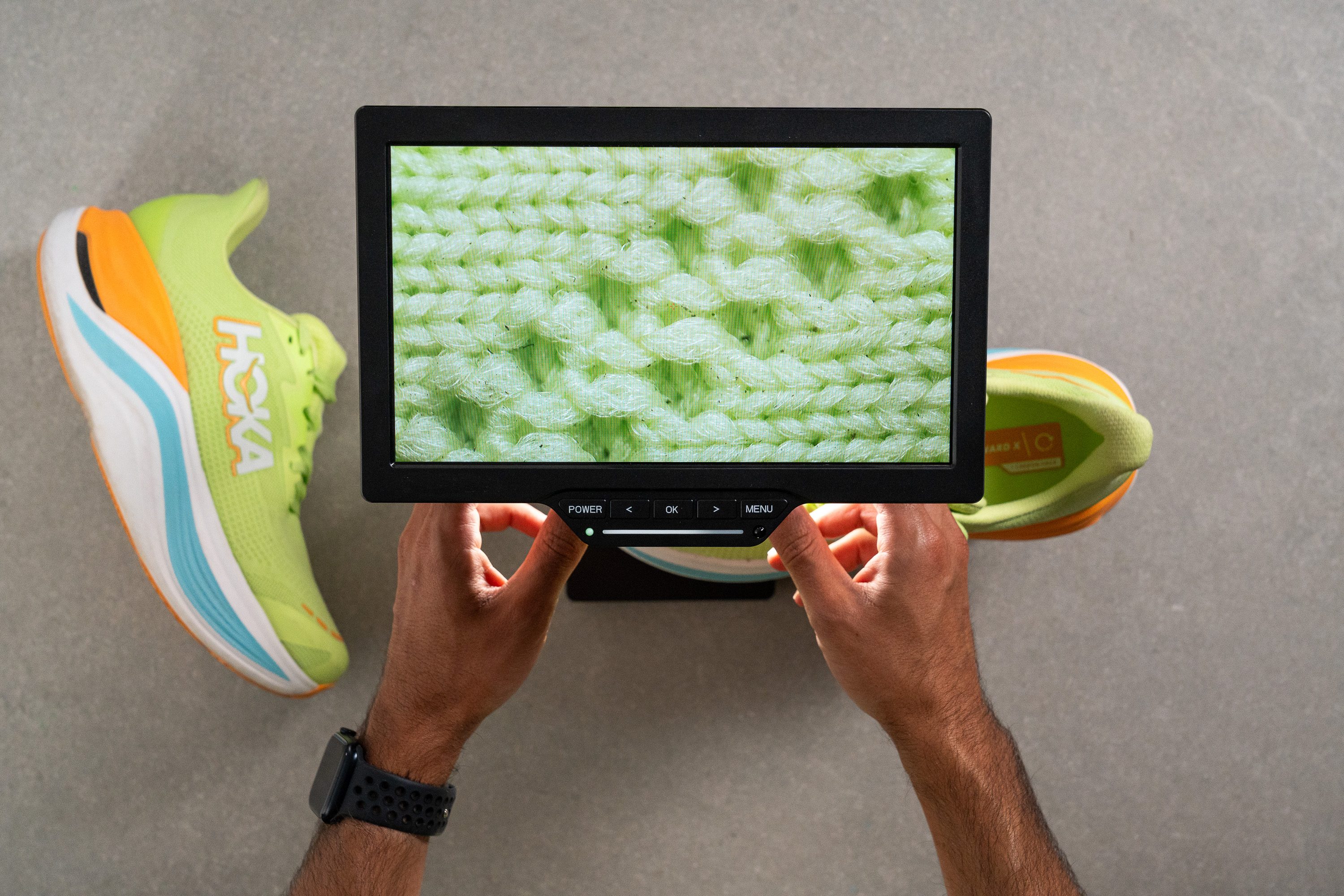
Further investigations using a microscope allowed us to pinpoint the precise placement of ventilation holes across the entire toebox.
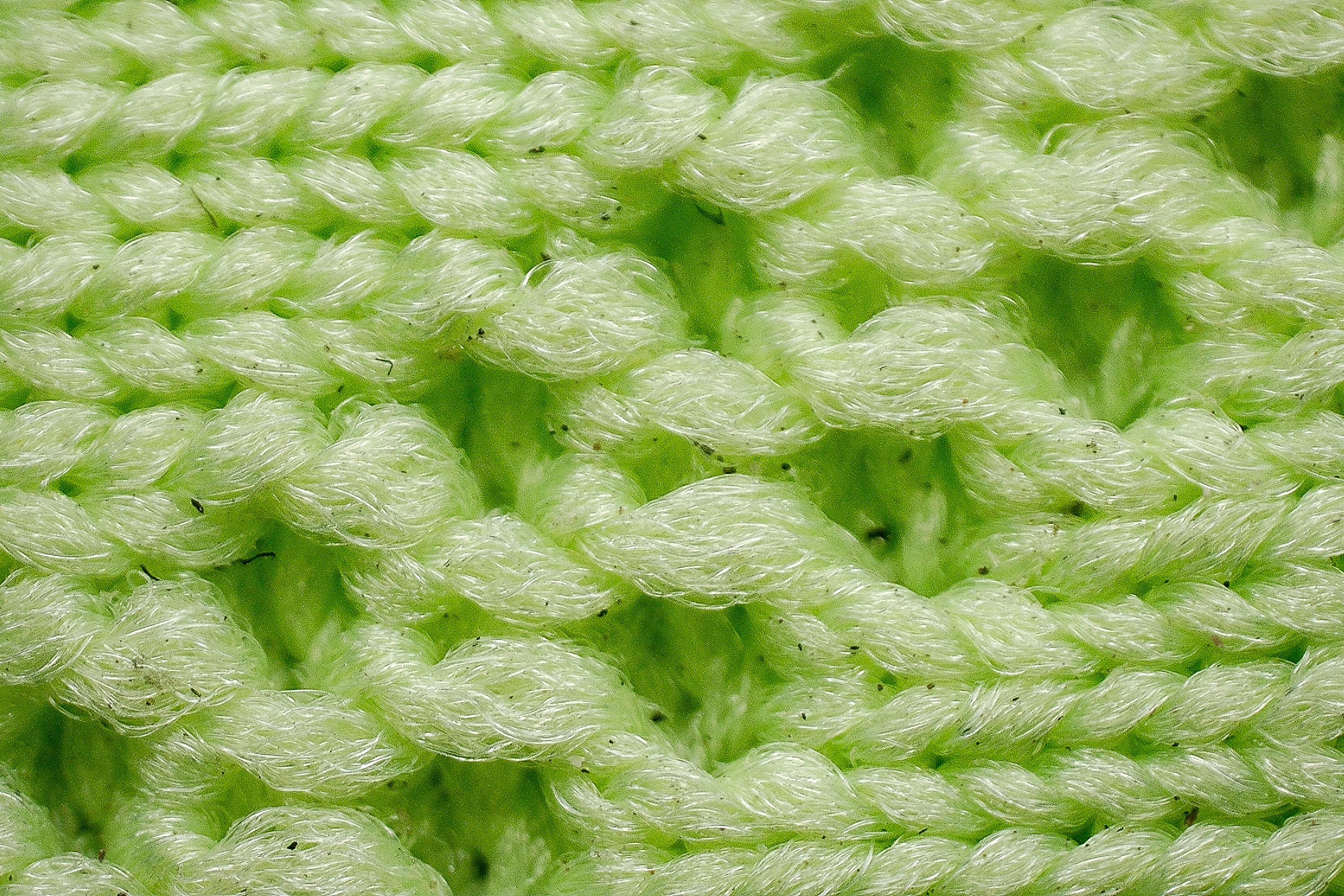
This detailed approach underscores the importance of conducting multiple tests to assess breathability—if we had relied solely on the microscope, we might have concluded that air flow could be restricted.
Overall, the upper is impressively crafted, offering the quality and performance you'd expect from a premium-priced shoe.
| Hoka Skyward X | 5 |
| Average | 3.7 |
Stability
Lateral stability test
Although the Skyward X stands as one of the tallest shoes we've evaluated in our lab, its stability is impressive for several reasons: the convex carbon plate, the ultra-stiff heel counter, substantial overall dimensions, and broad sidewalls contribute to its secure feel.
Is it the ideal choice for runners with stability needs? Perhaps not—we believe it doesn't quite fit that category. However, for neutral runners seeking a cushioned shoe that provides a sense of security during their runs, the Skyward X certainly stands out, despite some compromises.
Torsional rigidity
We anticipated that the H-shaped carbon plate in the Skyward X might add some flexibility, but this simply wasn't the case. The substantial stack height combined with the natural stiffness of carbon fibre resulted in a shoe that is exceptionally rigid, unable to bend or twist. Consequently, it scored a well-deserved 5/5.
| Hoka Skyward X | 5 |
| Average | 3.5 |
Heel counter stiffness
Running shoes typically feature a single heel counter, often a flexible piece of cardboard that goes inside the upper. However, in a bid for enhanced stability, the Skyward X incorporates two heel counters—one internal and one external—adopting a design usually reserved for stability shoes. Given its substantial stack height, this approach may seem justified for some.
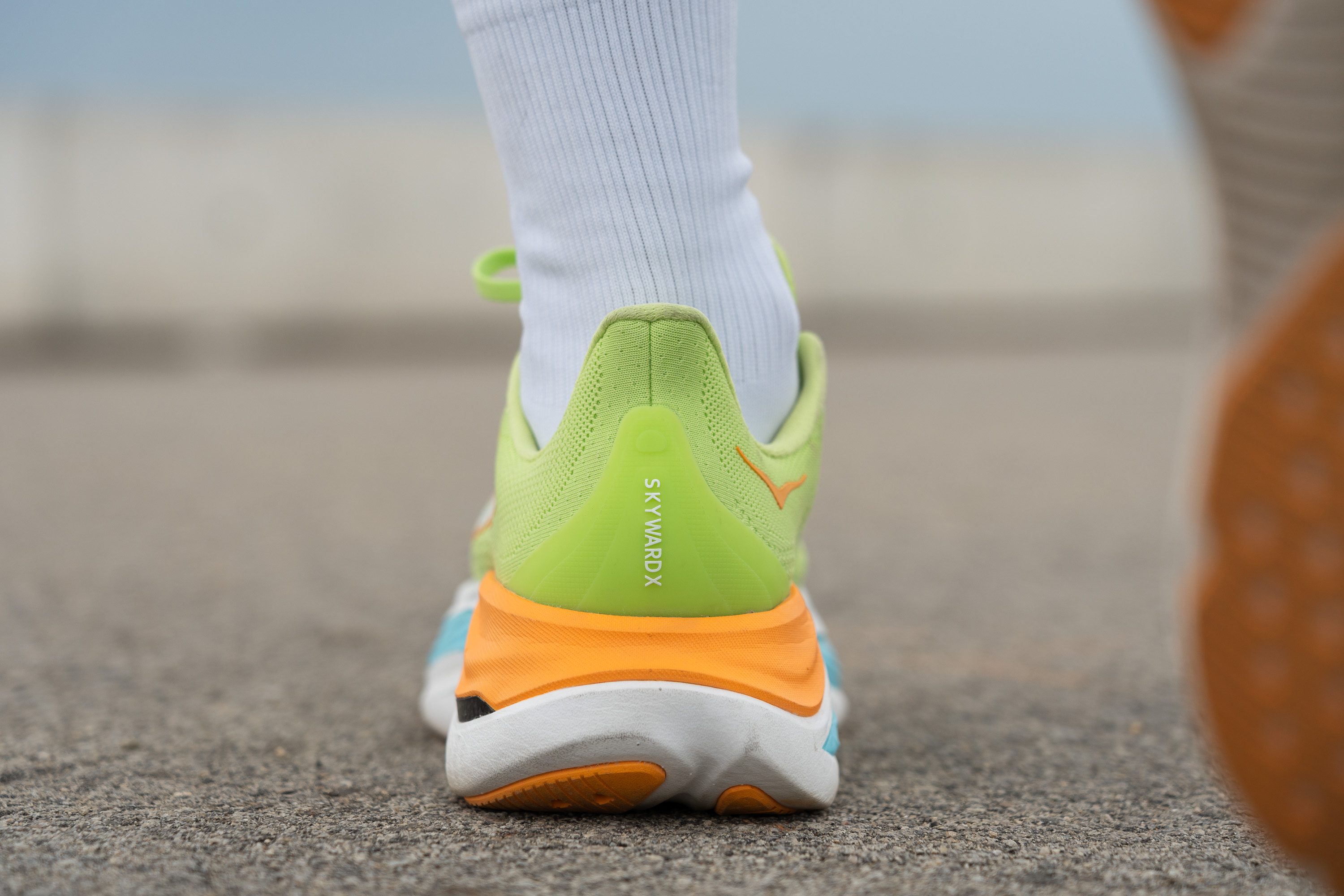
On the downside, such a rigid setup might pose issues for runners with sensitive heels, such as those suffering from Haglund's deformity.
| Hoka Skyward X | 5 |
| Average | 2.9 |
Midsole width - forefoot
If we compared this shoe to a vehicle, it would undoubtedly be a massive SUV—think Cadillac Escalade or Hummer. That's the level of bulk we're talking about here, a fact confirmed by our measurements.
In our lab tests, we recorded a staggering 123.7 mm in the forefoot, a size almost unheard of in the lab, even for stability shoes. Nonetheless, this immense dimension contributes significantly to the supportive feel during runs, yet it also brings the typical drawbacks of a larger, clunkier shoe.
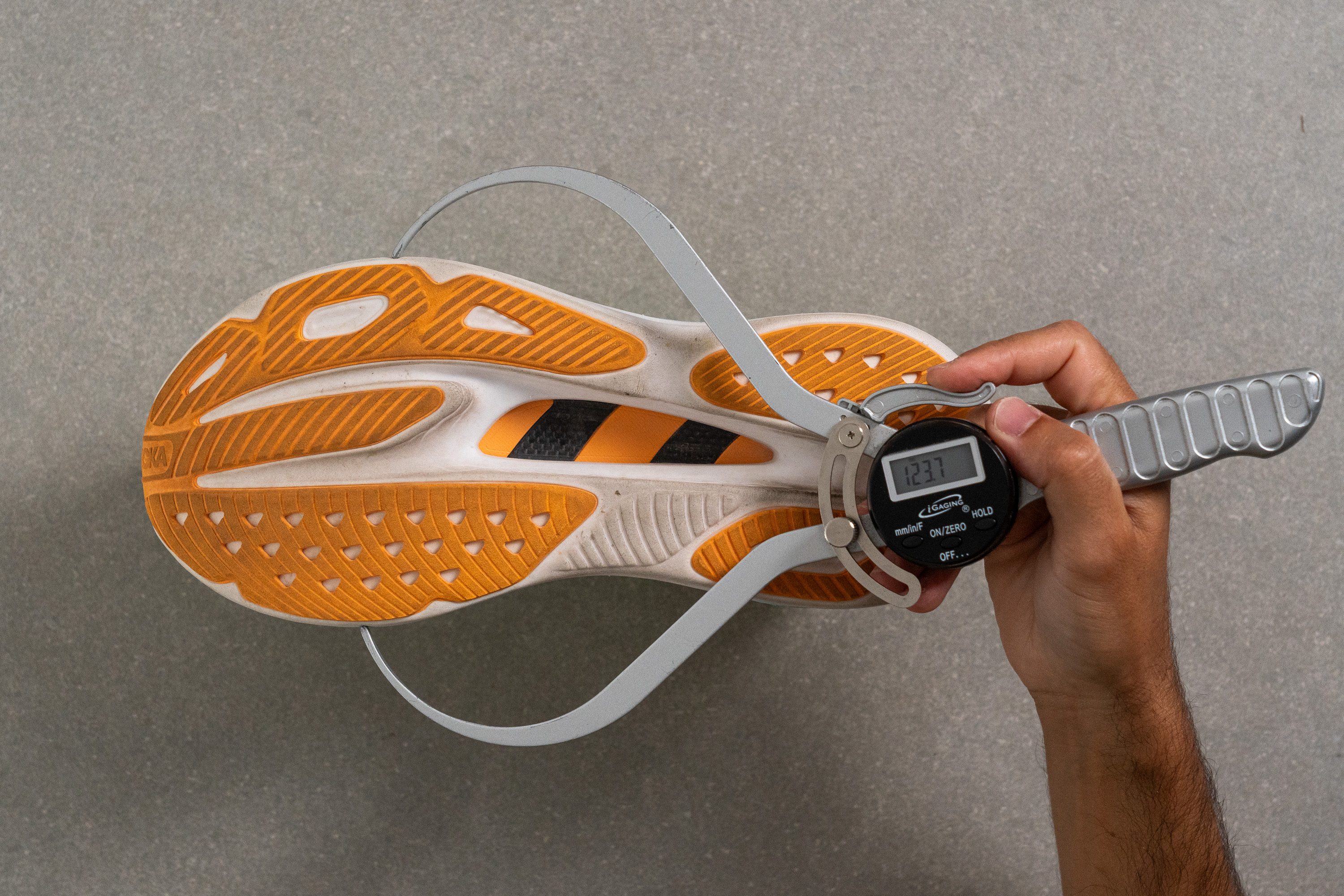
| Hoka Skyward X | 123.7 mm |
| Average | 114.4 mm |
Midsole width - heel
The heel of this running shoe is notably broader even than many stability shoes, clocking in at an impressive 100.1 mm.
Such a generous width provides an expansive landing area for heel strikers, firmly establishing the Skyward X as one of the top supertrainers for heel strikers in our assessment.

| Hoka Skyward X | 100.1 mm |
| Average | 90.7 mm |
Durability
Toebox durability
At a price tag of £220, we're not just expecting good ventilation—we're looking for durability as well. While there have been instances where Hoka's durability might have been underwhelming like the Mach 6, this time it seems they've taken those lessons to heart.
In our toebox durability test, the Skyward X delivered impressively, earning a robust 4/5 rating. This is particularly notable for a soft knit upper, which typically challenges durability standards. We also want to highlight that the toe cap includes multiple TPU overlays, enhancing protection in gravel roads or easy trails.
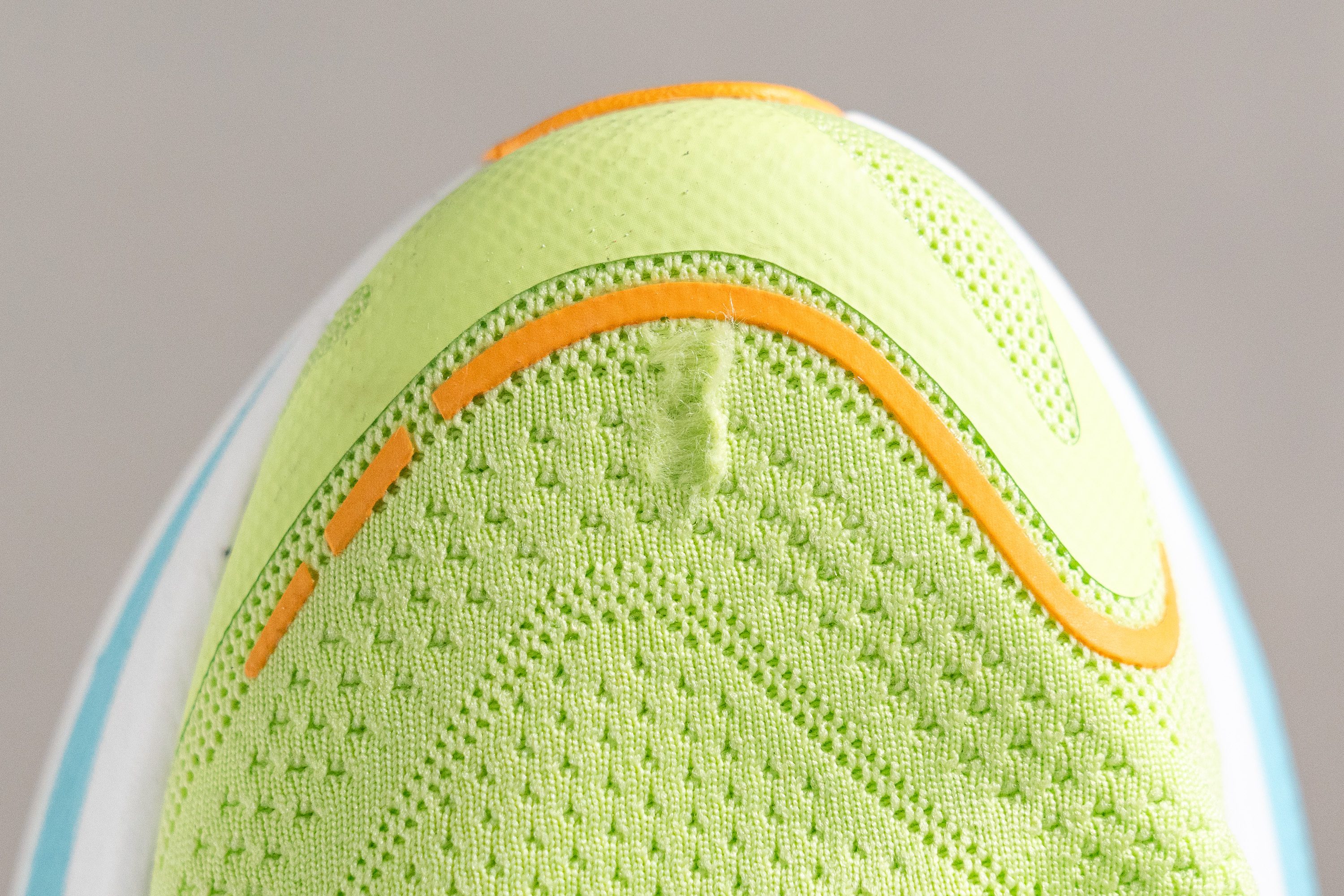
| Hoka Skyward X | 4 |
| Average | 2.6 |
Heel padding durability
And wait until you hear about our heel padding challenge.
We put the shoe through our standard Dremel test—running it at 5K revolutions per minute with 3.2N of force. The outcome was phenomenal, as it earned a rare perfect score of 5 out of 5 in our lab.
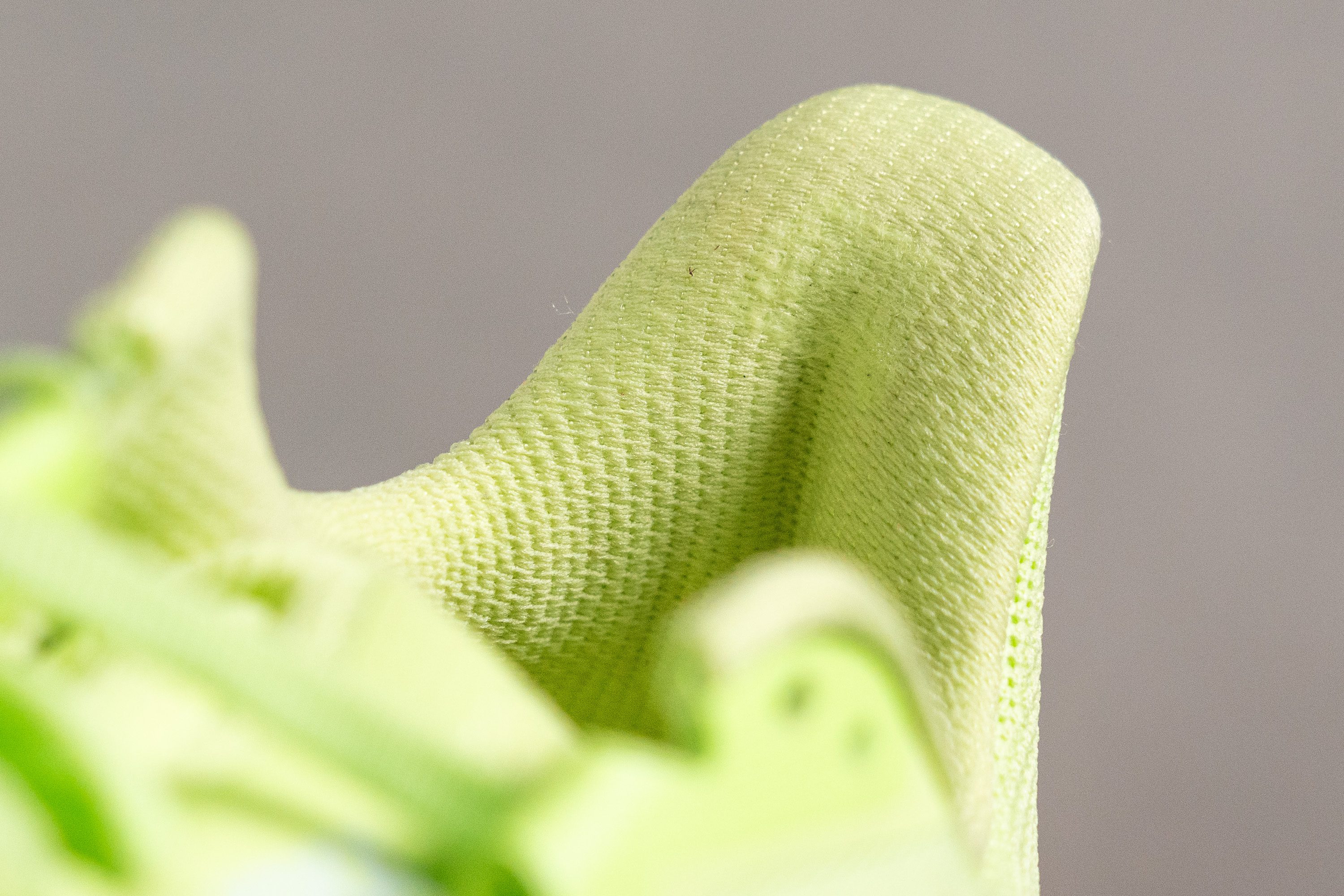
| Hoka Skyward X | 5 |
| Average | 3.4 |
Outsole hardness
We've really put the upper through its paces to gauge its durability and performance—yet, there's more to this shoe than just a robust knit. Now, we turn our attention to the outsole, crucial for justifying its sky-high price.

We applied our durometer to the high-abrasion rubber and discovered that Hoka opted for a remarkably soft compound, registering just 71.8 HC. This choice clearly aims to boost grip, enhancing the shoe’s performance on various surfaces.
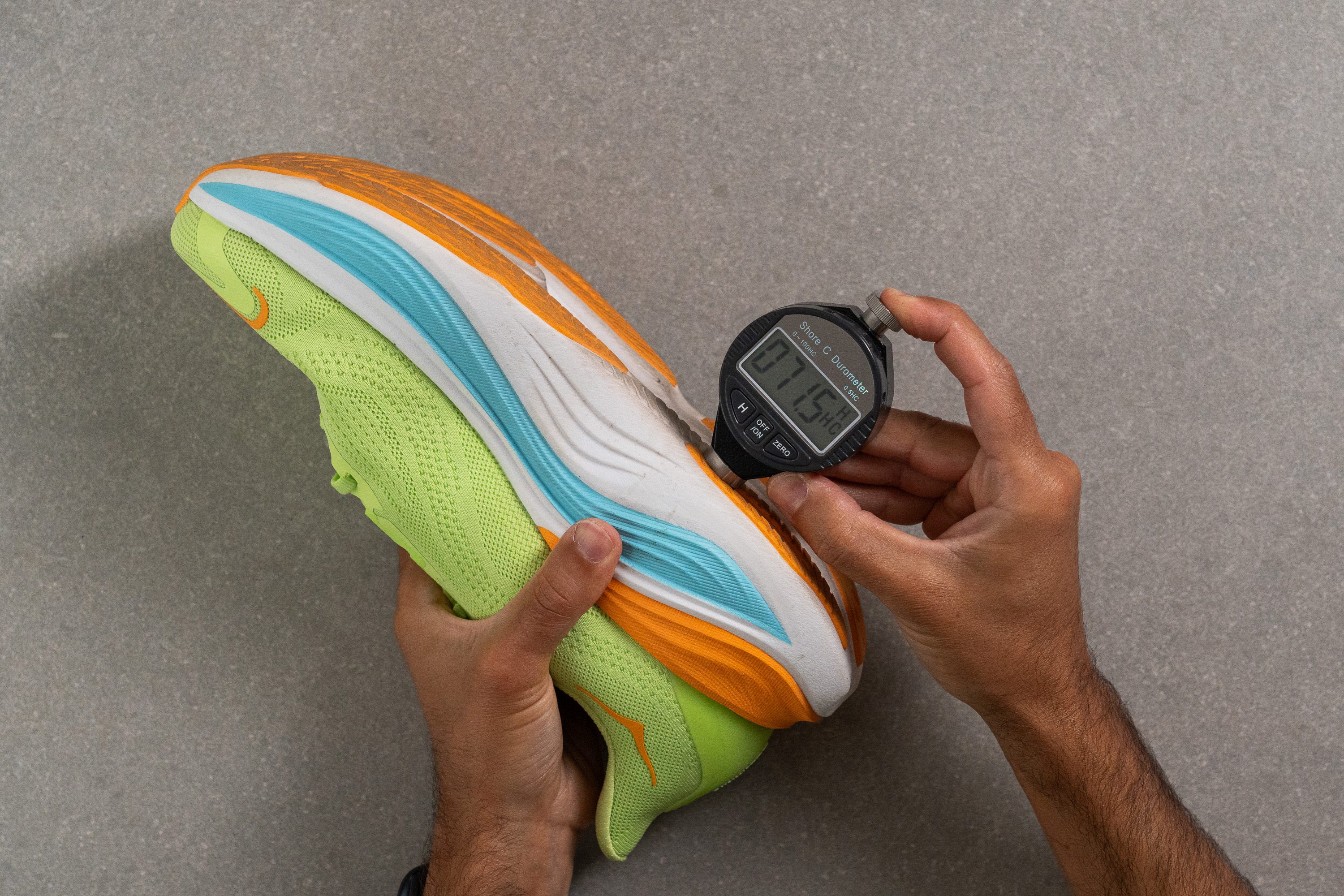
| Hoka Skyward X | 71.8 HC |
| Average | 79.2 HC |
Outsole durability
Initially, we had our doubts about the durability due to the soft rubber formulation—however, it's best to reserve judgement until after we finish our testing.
We ramped up our Dremel to 10K RPM for a demanding durability test in our lab. The outcome was good—a mere 0.8-mm indentation solidly confirmed that this high-abrasion rubber not only provides exceptional all-weather grip but also stands up well to wear and tear.
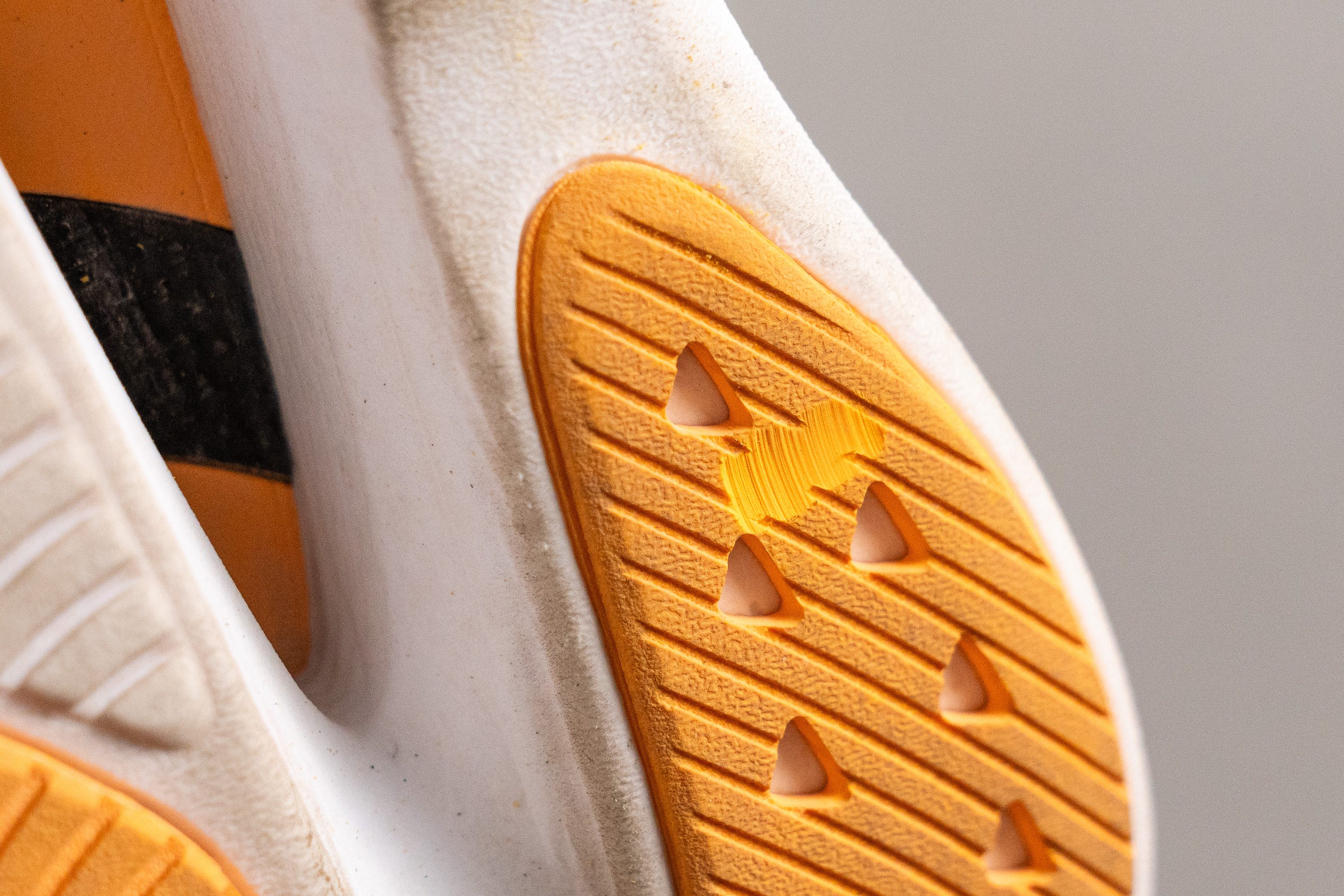
| Hoka Skyward X | 0.8 mm |
| Average | 1.1 mm |
Outsole thickness
To conclude our examination of the outsole, we measured a thickness of 3.1 mm—sufficient according to our previous tests. However, we believe Hoka could reduce this slightly to lighten the shoe. You'll soon understand why.
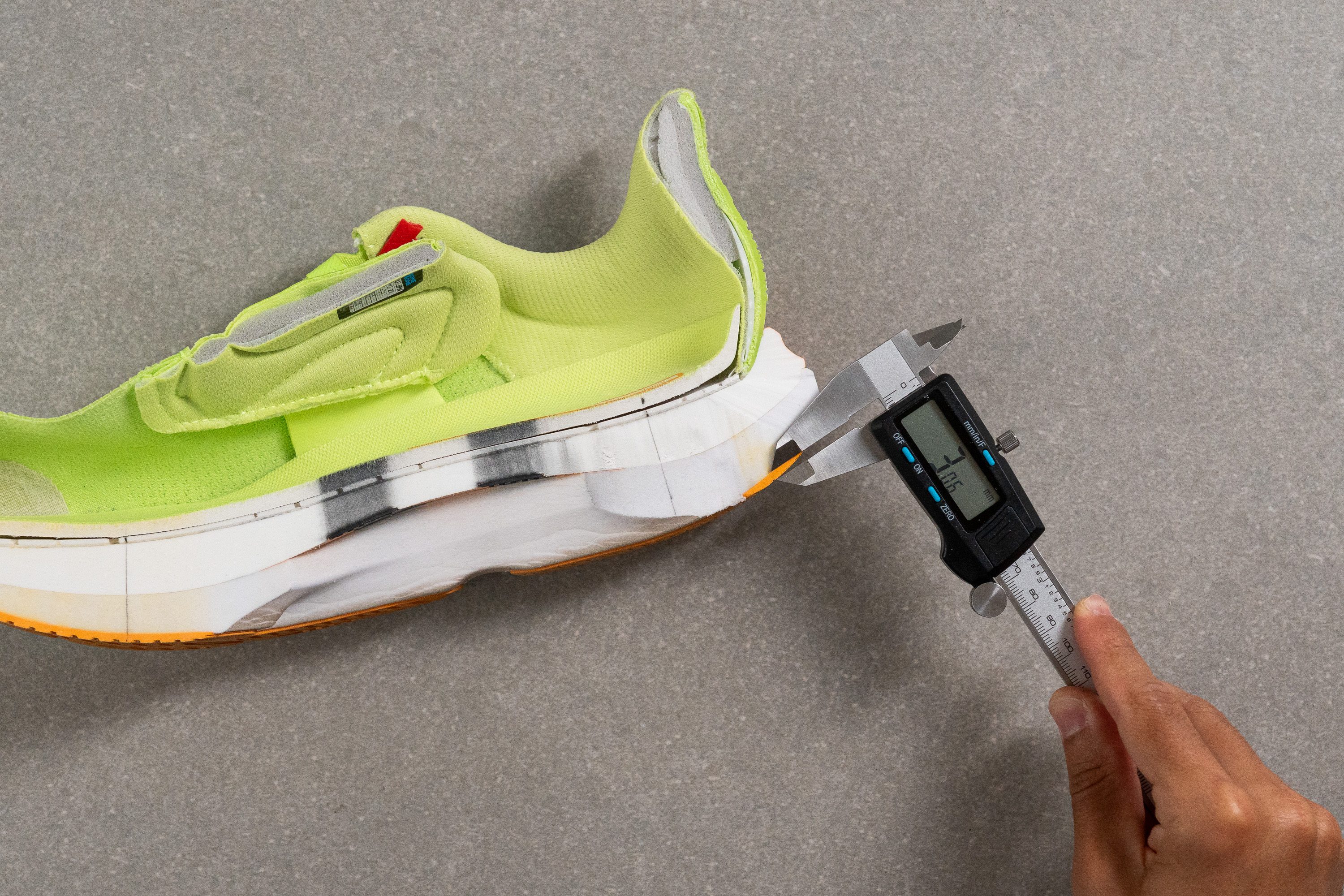
| Hoka Skyward X | 3.1 mm |
| Average | 3.2 mm |
Misc
Insole thickness
The insole is standard, identical to what Hoka uses in many other models, with a typical thickness of 4.2 mm.
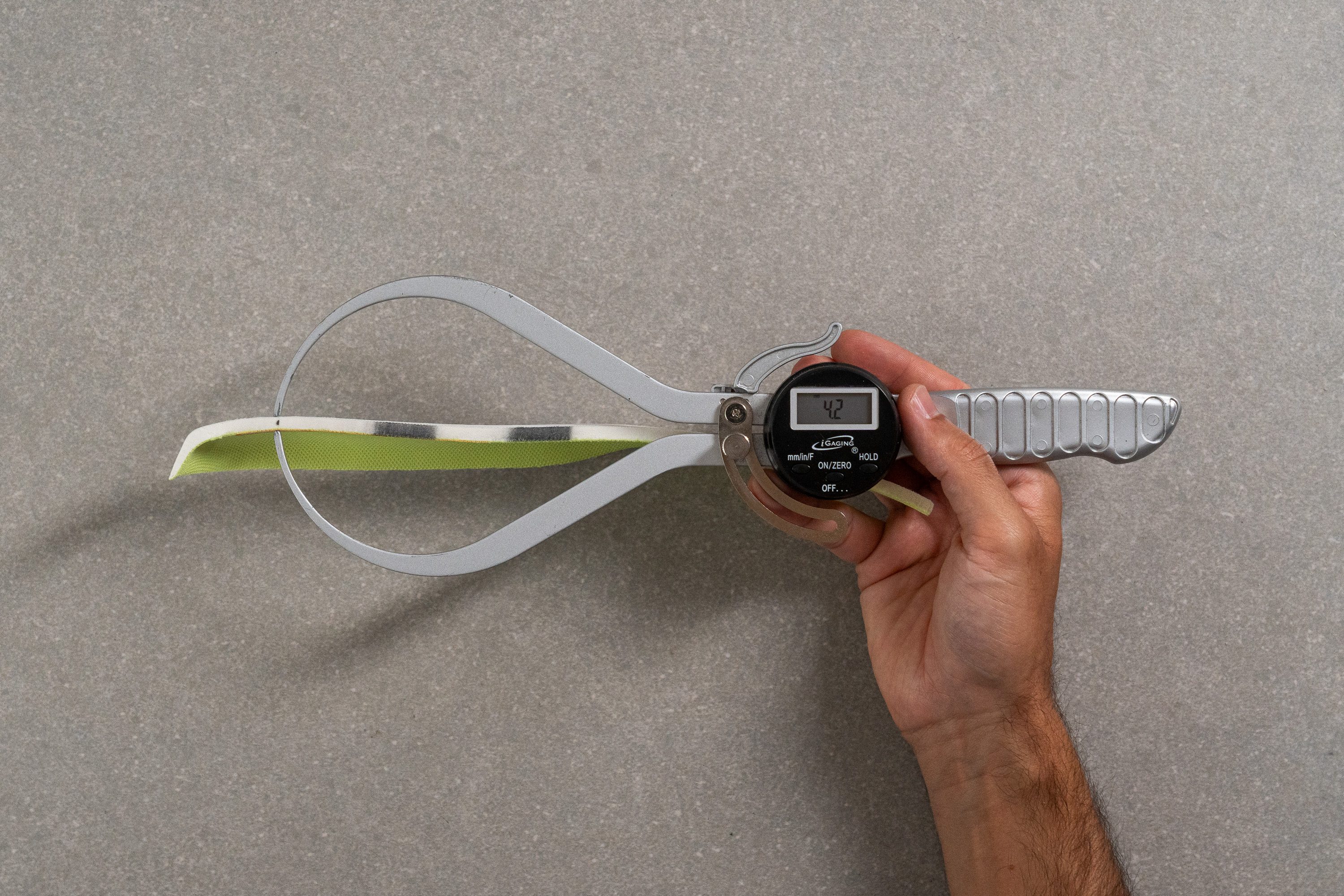
| Hoka Skyward X | 4.2 mm |
| Average | 4.5 mm |
Removable insole
We easily removed the insole of the Skyward X and experimented with various third-party insoles and even some custom orthotics. However, we discovered that thinner options are essential, as the internal space of the shoe is limited.
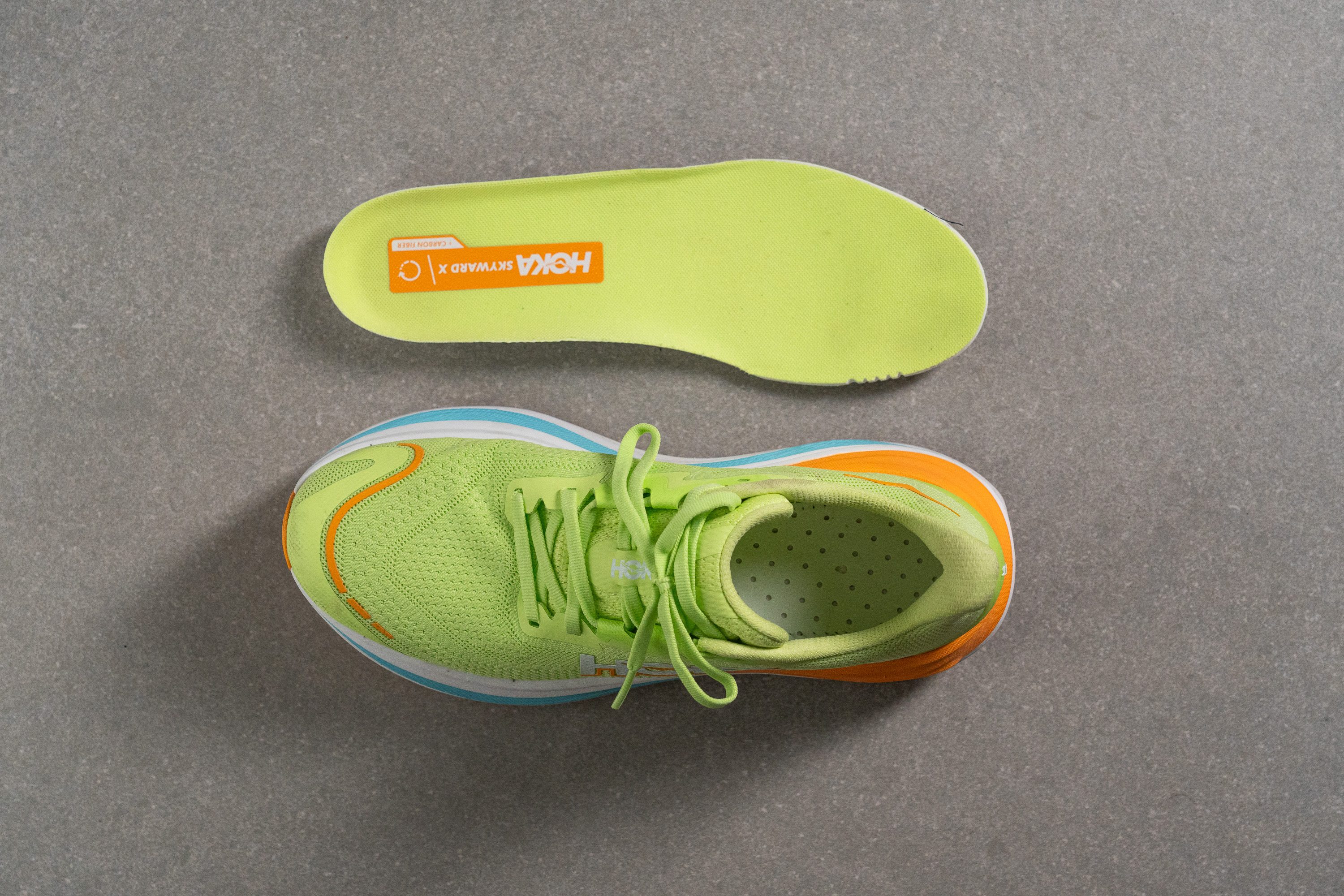
| Hoka Skyward X | Yes |
Midsole softness in cold (%)
We placed the Skyward X in a freezer for 20 minutes to assess how the foam would behave under cold conditions. Impressively, the softness of the foam only decreased by a minimal 1.3%. This outcome was so outstanding that it was almost hard to believe!
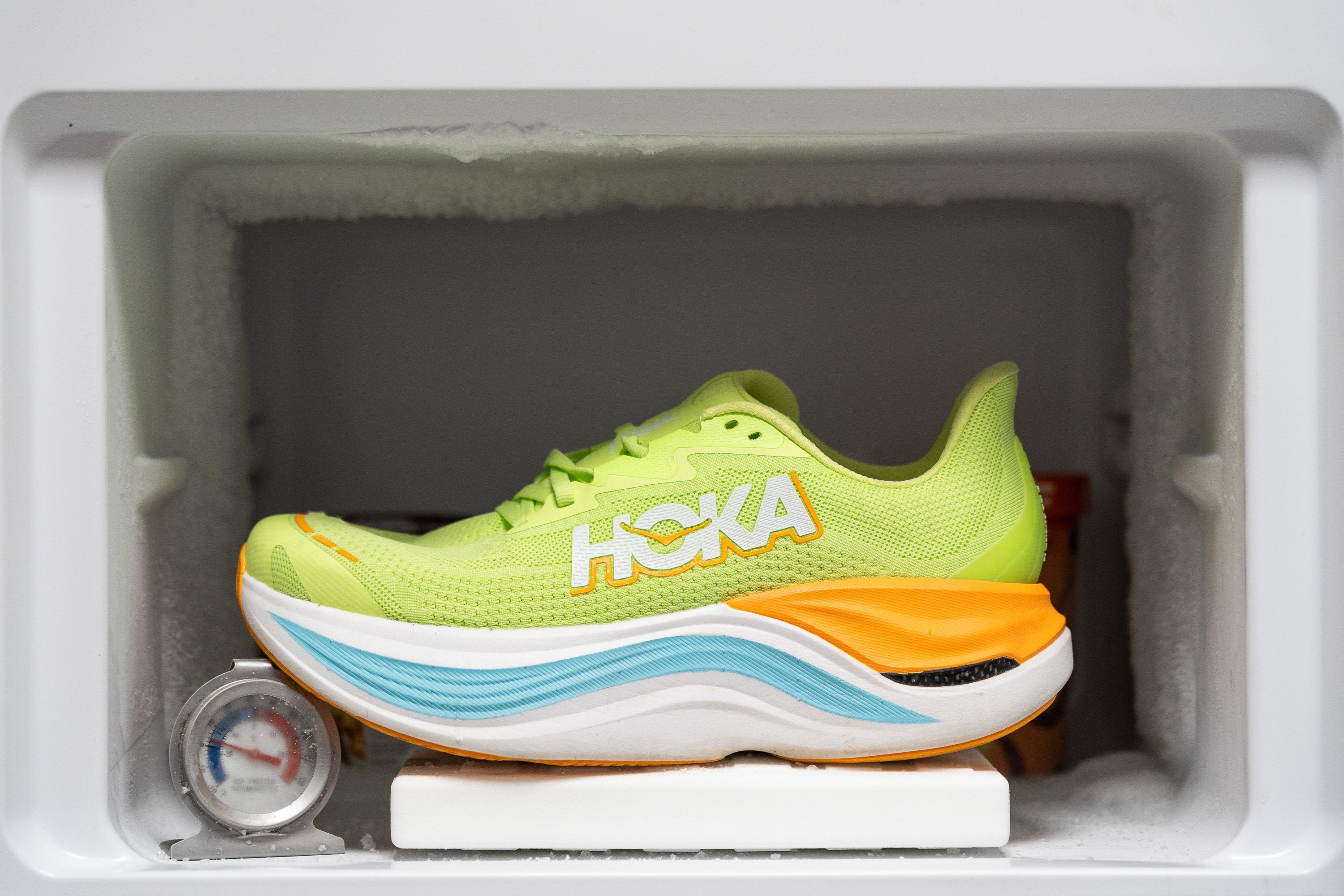
| Hoka Skyward X | 1% |
| Average | 24% |
Reflective elements
Spending £220 on the Skyward X does not get you reflective elements—a feature we've come to expect from Hoka in recent years.
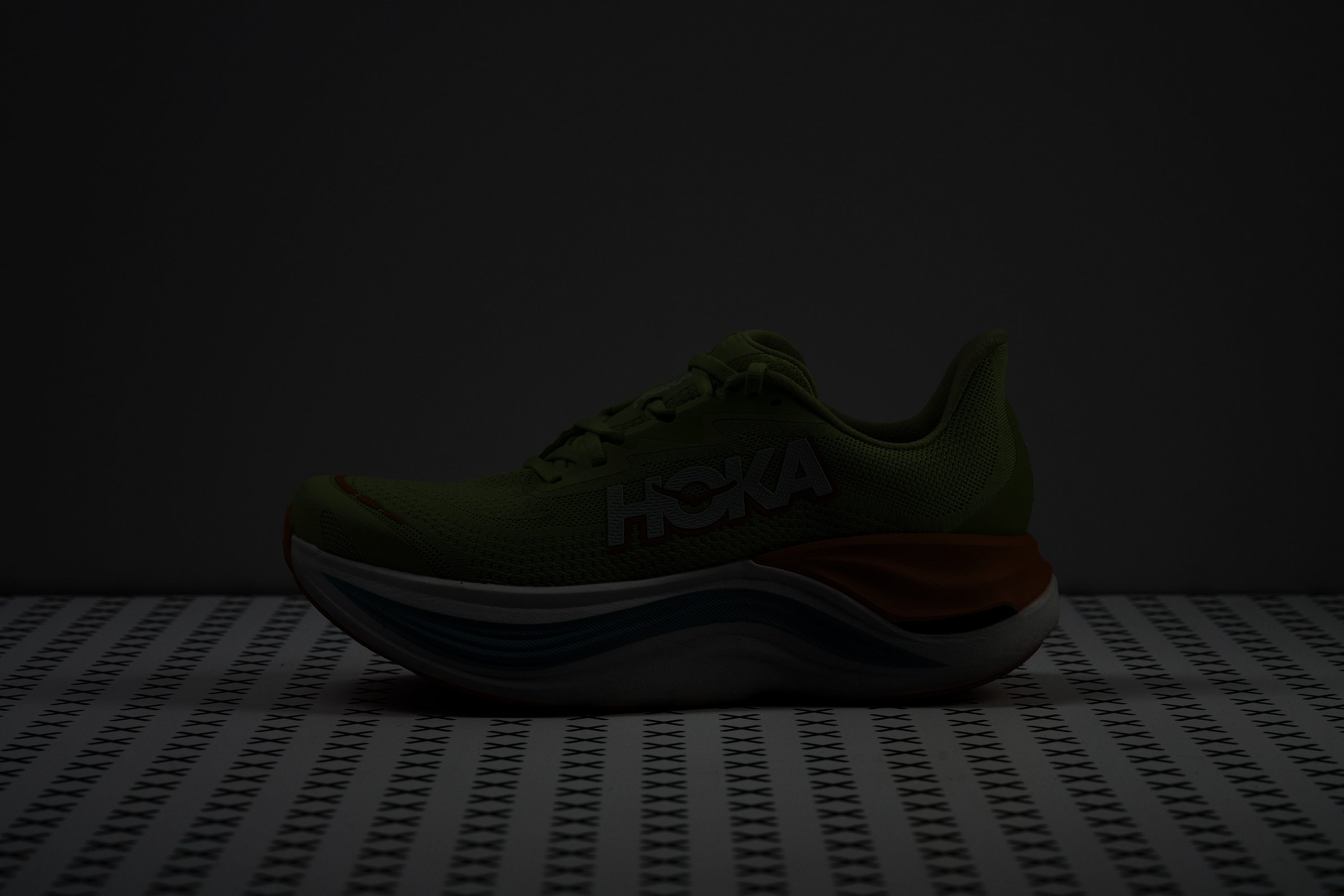
| Hoka Skyward X | No |
Tongue padding
The tongue boasts a substantial 9.5 mm of comfy foam padding—a bit excessive in our view.
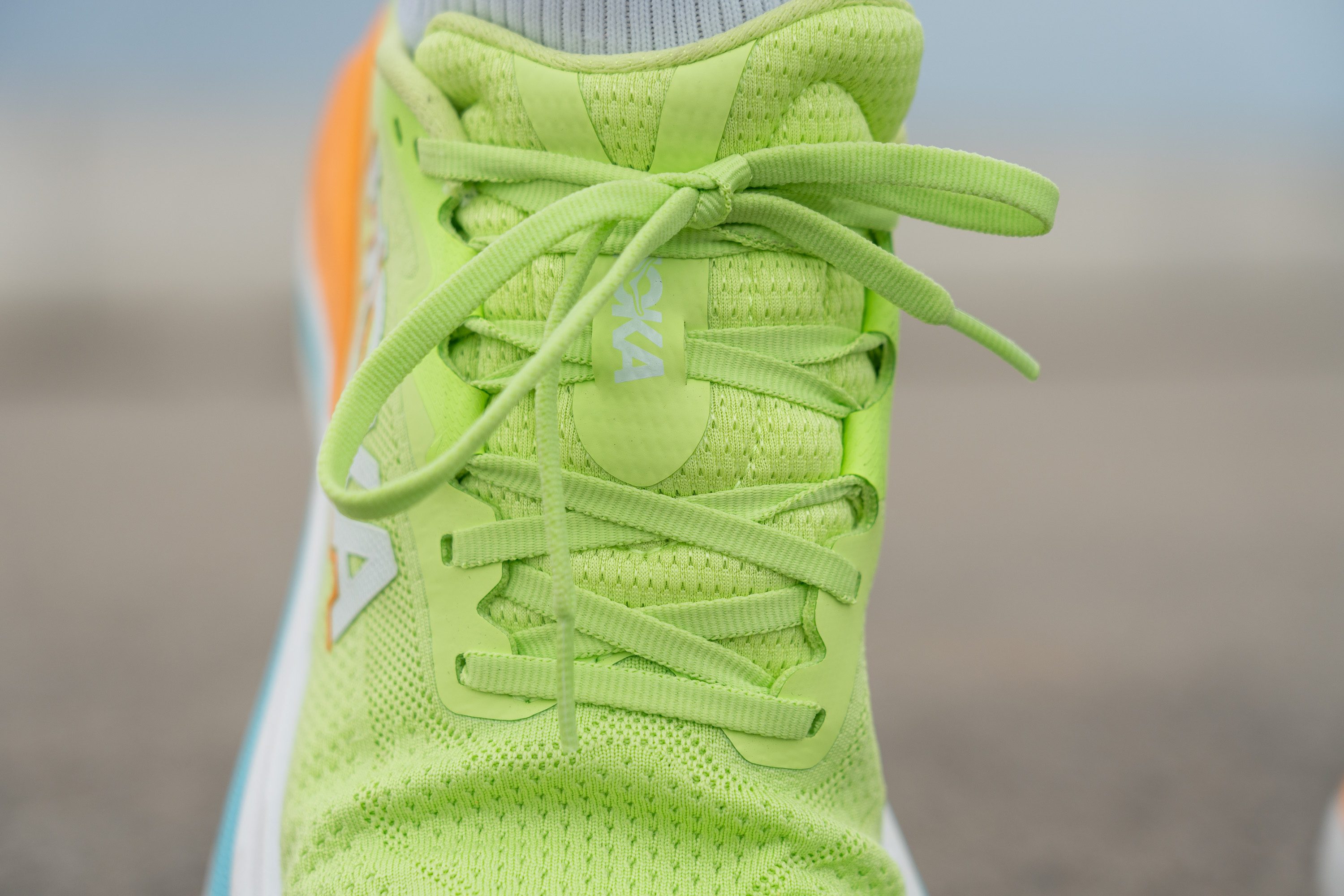
We believe a slimmer 4 or 5 mm thickness would suffice, providing ample comfort within the performance-fit upper while also reducing the shoe's overall weight.
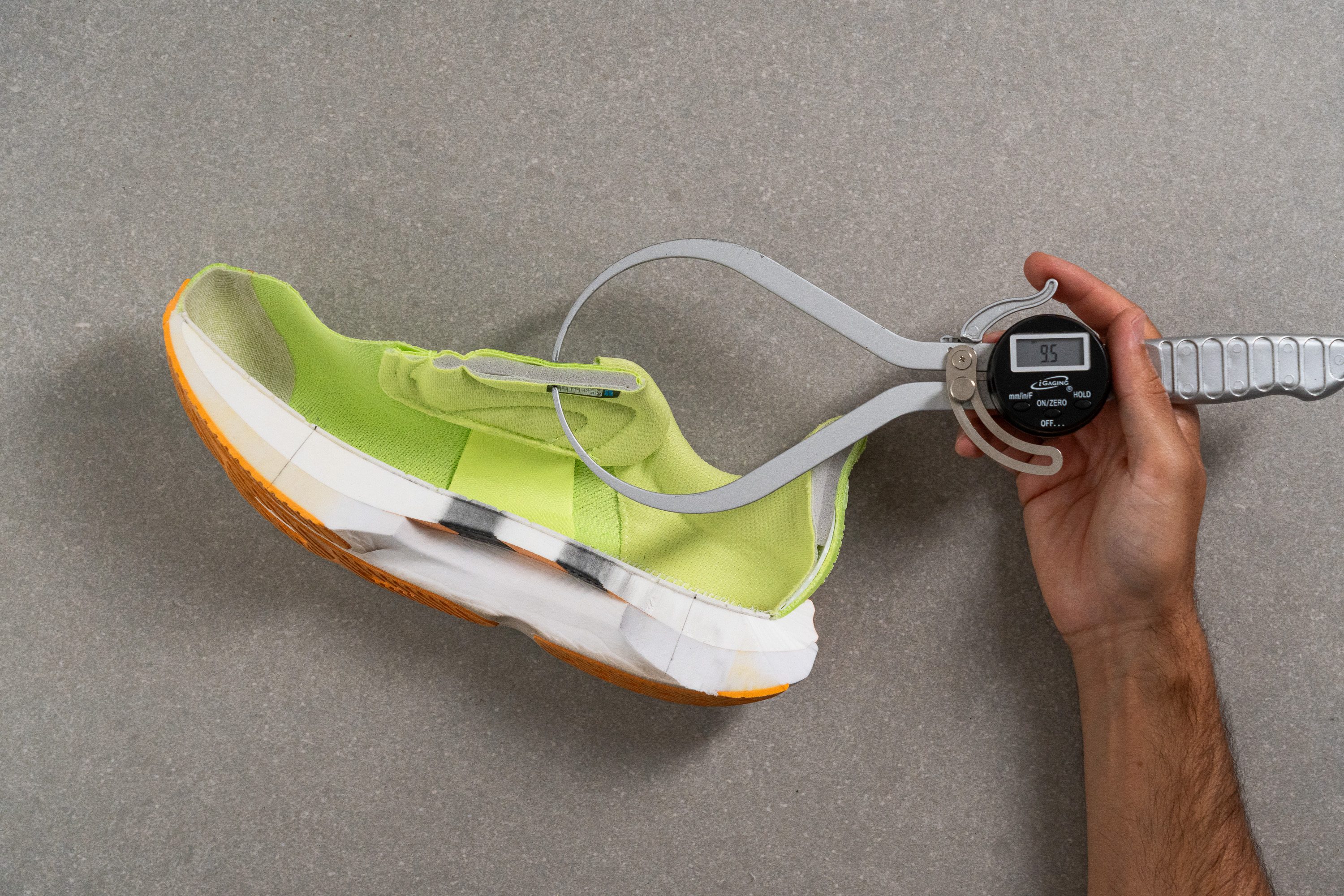
| Hoka Skyward X | 9.5 mm |
| Average | 5.8 mm |
Tongue: gusset type
While the snug fit of the upper prevents the tongue from shifting, we find the absence of a gusseted tongue in a £220 shoe disappointing and believe it should be addressed in the next update.
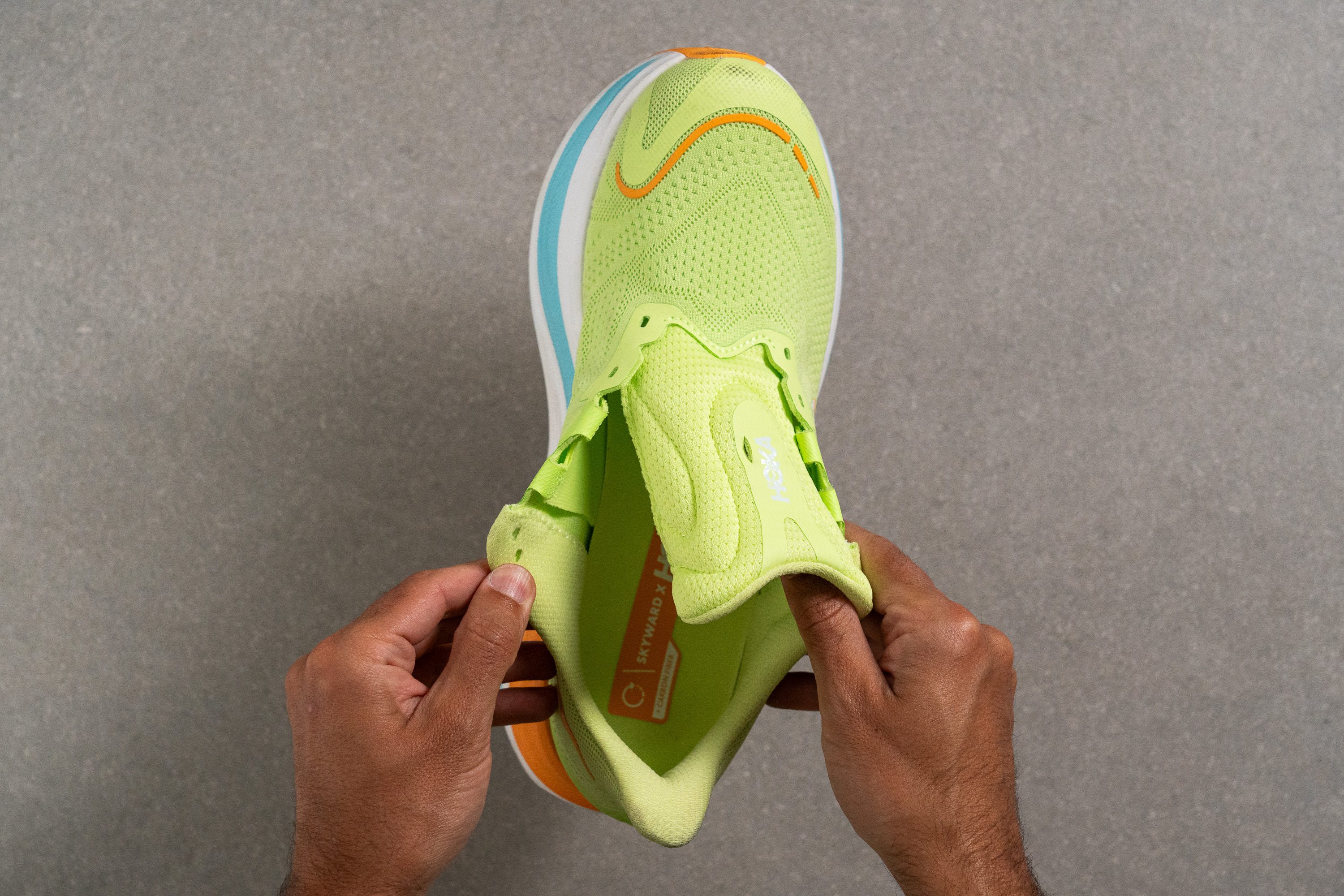
| Hoka Skyward X | None |
Heel tab
True to Hoka's roots, the heel of the Skyward X skips the traditional finger-loop tab and instead features the iconic swallowtail extended heel collar. We found this design not only easy to grab but also effective in reducing pressure on the Achilles tendon.
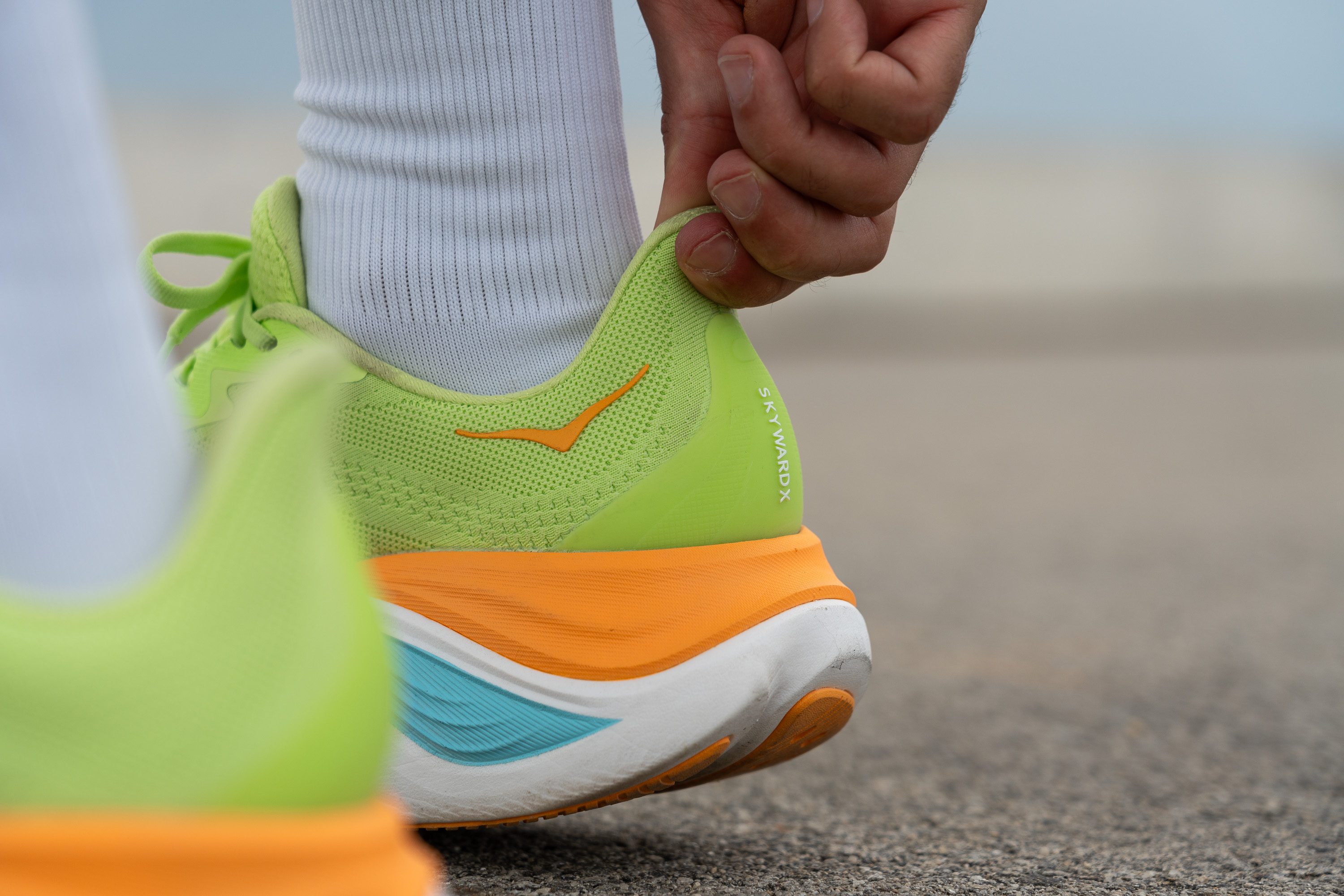
| Hoka Skyward X | Extended heel collar |

